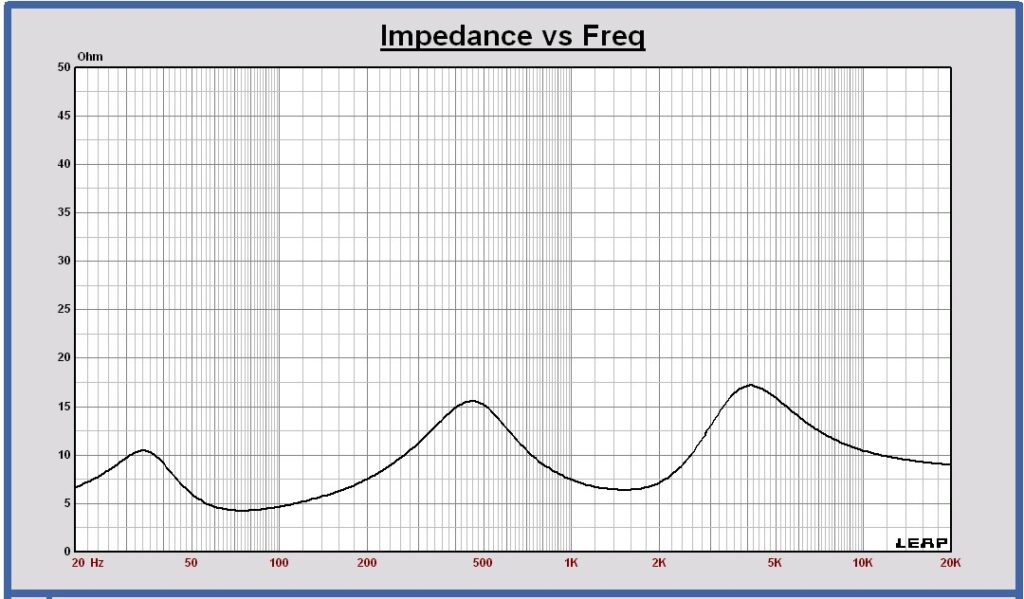4-way loudspeaker with Purifi 8” Al woofers, Purifi 8″ Al midwoofer, Bliesma 3” Be dome midrange and Bliesma 1″ Be dome tweeter – DSP, ASP or passive filtering
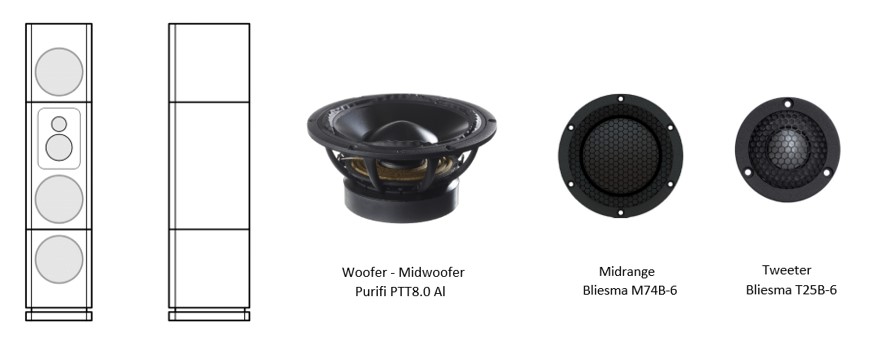
The VCL EX27 is a concept study with Purifi loudspeaker drivers and Bliesma beryllium domes.
It is a 4-way tower speaker with three separate cabinets stapled on each other. A 3-way part in the middle, that can operate independently also. Two woofer modules, placed under and on top of the 3-way cabinet, to make it a 4-way tower. It is possible to start with the 3-way and add the extra woofers later.
Purifi and Bliesma belong to the most advanced transducer manufacturers today. For the woofers two of the new Purifi 8 inch aluminimum cone drivers PTT8.0X08-NAB-02 are chosen, each in a separate cabinet and for the midwoofer the 4 Ohm version of the same 8 inch woofer. For the midrange and the tweeter the Bliesma Be domes, M74B-6 and T25B-6. These are all drivers with very low distortion and high linear excursion capability.
The two woofers, positioned in the cabinet in this way, together with their ground reflected mirror drivers, results in a line array which causes some beaming at low frequencies. In a way the directivity index increases and the roompower becomes more flat at low frequencies.
The 8 inch midwoofer, the 3 inch midrange and 1 inch tweeter, mounted in this cabinet, each show a flat directivity index curve with a good overlap to the adjacent driver ways. The speaker directivity index can be designed flat and the room power kept constant from about 200 Hz up to 6000 Hz with this setup.
A crossover filter with generic filter blocks is designed. It can be transformed to biquad filters for DSP programming or to analog opamp filter blocks to make an active analog ASP version of it.
For the 3-way to be used separately, a passive filter version is designed.
Some numbers of this 4-way speaker. The cabinet is 140 cm high (incl. foot), 31 cm wide and 38 cm deep. Sensitivity is 85 dB at 1m, 2.83 Vrms, full space, F3 = 40 Hz and maximum SPL is 99.3 dB @ 1m, full space.
Contents
- Specification Headlines
- Estimation Bill Of Material
- Speaker System
- Cabinet
- SPL and impedance curves of the transducers in the cabinet
- Polar diagrams of the transducers in the cabinet
- Off axis response, power and Directivity Index of the transducers in the cabinet
- Active crossover filter with generic filter blocks
- Maximum excursion and maximum SPL with crossover filter
- DSP digital active crossover filter
- ASP analog active crossover filter
- Passive filter 3-way module
Specificaton Headlines
- System: 4-way, woofer and midwoofer closed box system, DSP, ASP, passive X-over
- Woofers: 2 x Purifi PTT8.0X08-NAB-02 parallel
- Midwoofer: Purifi PTT8.0X04-NAB-02
- Midrange: Bliesma M74B-6
- Tweeter: Bliesma T25B-6
- Low frequency response: F3 = 40 Hz, F6 = 31 Hz and F12 = 20 Hz
- Sensitivity: 85 dB at 1m, 2.83 Vrms, full space
- SPL at maximum excursion, 40 – 20000 Hz: 99.3 dB, 1m, full space
- Crossover: LR4 110, 550 and 2750 Hz
- Cabinet dimensions incl. foot: width x heigth x depth = 31 cm x 140 cm x 38 cm
Estimation Bill Of Material exclusive crossover filter
- 4 x Woofer: Purifi PTT8.0X08-NAB-02: 2280 euro
- 2 x Midwoofer: Purifi PTT8.0X04-NAB-02:: 1140 euro
- 2 x Midrange M74B-6: 1300 euro
- 2 x Tweeter: Bliesma T25B-6: 500 euro
- Cabinet material: 300 euro
- Cabinet Accessoires: 150 euro
- Total: 5670 euro
System
Transducers

Purifi PTT8.0X08-NAB-02, Purifi PTT8.0X04-NAB-02, Bliesma M74B-6, Bliesma T25B-6
Two 8 inch transducers Purifi PTT8.0X08-NAB-02 parallel for the woofer. The driver sensitivity is 86.3 dB @ 2.83 Vrms, 1m and the maximum lineair excursion is 9.3 mm peak. An overall sensitivity of 85 dB can be realized for F3 = 40 Hz. The harmonic distortion is extremely low, better than -66 dB between 200 and 1000 Hz and better than -60 dB between 100 and 3200 Hz at 2.83 Vrms.
For the midwoofer one 8 inch transducer, the Purifi PTT8.0X08-NAB-02, the 4 Ohm version is used. With its 3dB higher sensitivity of 89.3 dB, it is possible to realize the wanted overall sensitivity of 85 dB for this 4 way loudspeaker.
As midrange the Bliesma 3 inch dome M74B-6 will be used. The sensitivity is 97 dB at 2.83 Vrms, 1m. The harmonic distortion of this transducer is very low, better than -60 dB between 900 and 3000 Hz at 2.83 Vrms. With a resonance frequency of 440 Hz and with its high sensitivity, this driver is capable to take over at 550 Hz, within its maximum lineair excursion of 1.2 mm peak.
The Bliesma T25B-6 is a 1 inch beryllium dome tweeter. The harmonic distortion of this transducer is low, better than -55 dB between 2200 and 8000 Hz at 2.83 Vrms. This tweeter has a flush mounted surround with the front plate which results in a very wide and flat SPL off axis.
Woofer – Small Signal Analysis
The two 8 inch Purifi woofers are placed each in a separate closed box of 27 L filled with sheep wool.
For this woofer: fs = 24 Hz; Vas = 74.5 L; Qts = 0.35 on infinite baffle (datasheet values).
Placed in the 27 L cabinet filled with wool: fc = 40.5 Hz and Qtc = 0.61.
The amount of filling can be determined by measuring the maximum impedance of the transducer at the frequency fc. It has to be about 33 Ohm for Qtc to be 0.61.
Midwoofer – Small Signal Analysis
The 8 inch Purifi midwoofer is placed each in a separate closed box of 24 L filled with sheep wool.
For this midwoofer: fs = 26 Hz; Vas = 70.4 L; Qts = 0.36 on infinite baffle (datasheet values).
Placed in the 24 L cabinet filled with wool: fc = 44.5 Hz and Qtc = 0.63.
The amount of filling can be determined by measuring the maximum impedance of the transducer at the frequency fc. It has to be about 18 Ohm for Qtc to be 0.63.
Cabinet
Cabinet dimensions
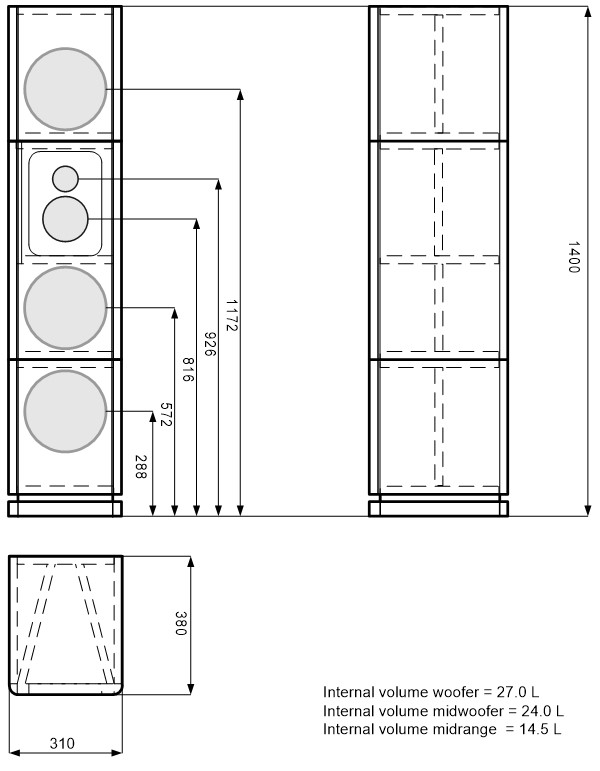
Cabinet in Leap
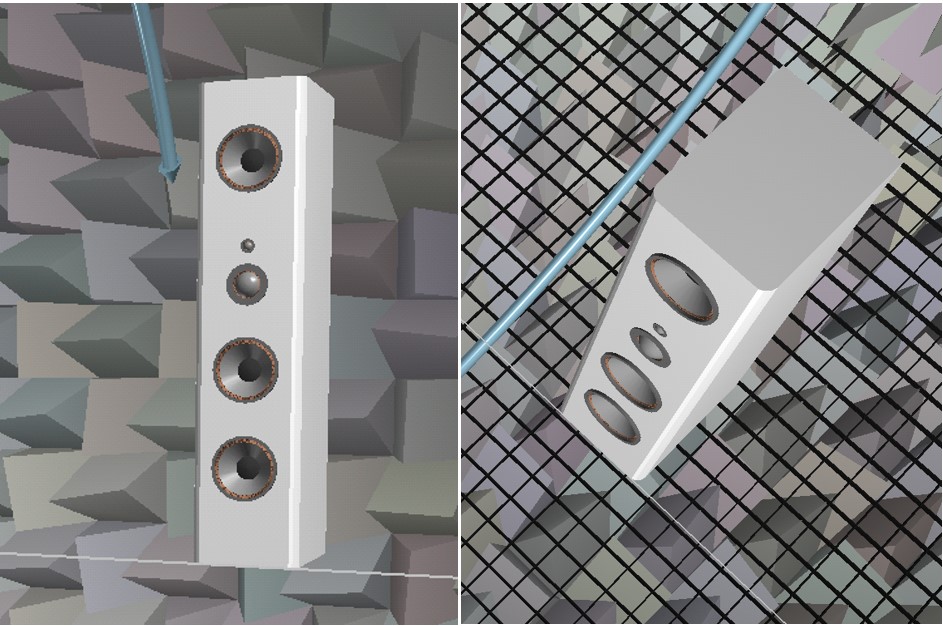
SPL and impedance curves of the transducers in the cabinet
These are the SPL and impedance curves of the transducers placed in the cabinet in free space at 3 meter, 2.83 Vrms . Also the SPL responses on infinite baffle are shown. The impact of the cabinet shape and diffraction on the response can be observed.
For the crossover design some frequency response corrections will be added as the SPL responses on infinite baffle of the transducer models used in the simulation are more smoothed.
SPL 2 woofers parallel, one in each cabinet, on-axis in free space (blue curve) and on infinite baffle (pink curve)
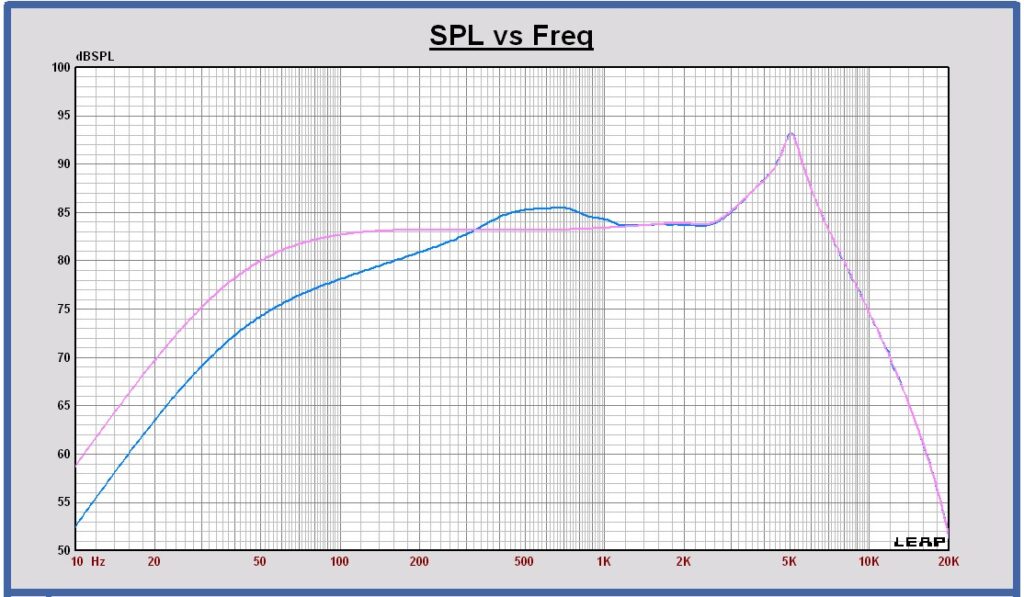
Impedance 2 woofers parallel, one in each cabinet
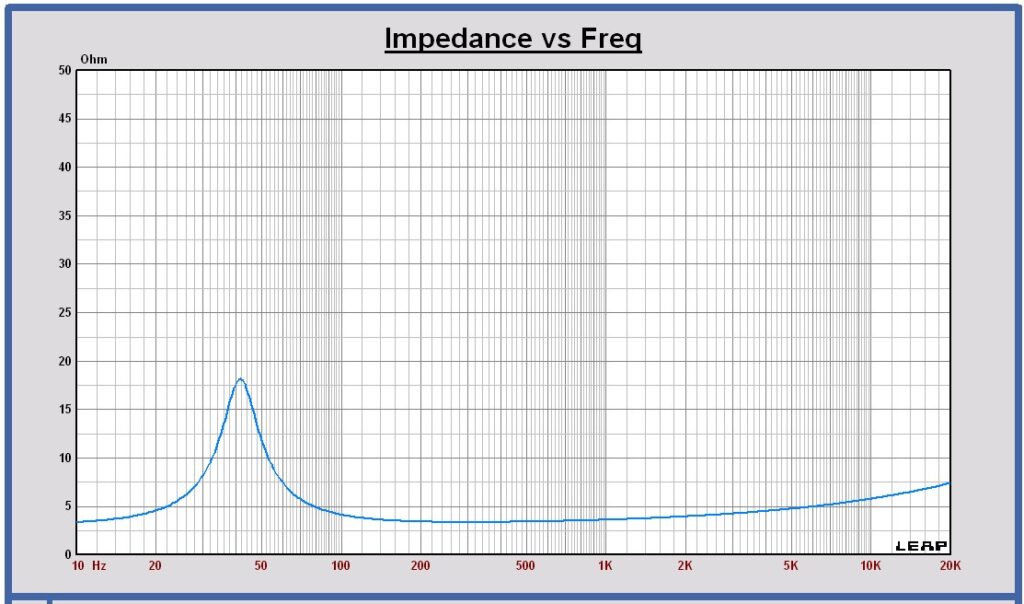
SPL midwoofer in the cabinet on-axis in free space (brown curve) and on infinite baffle (pink curve)
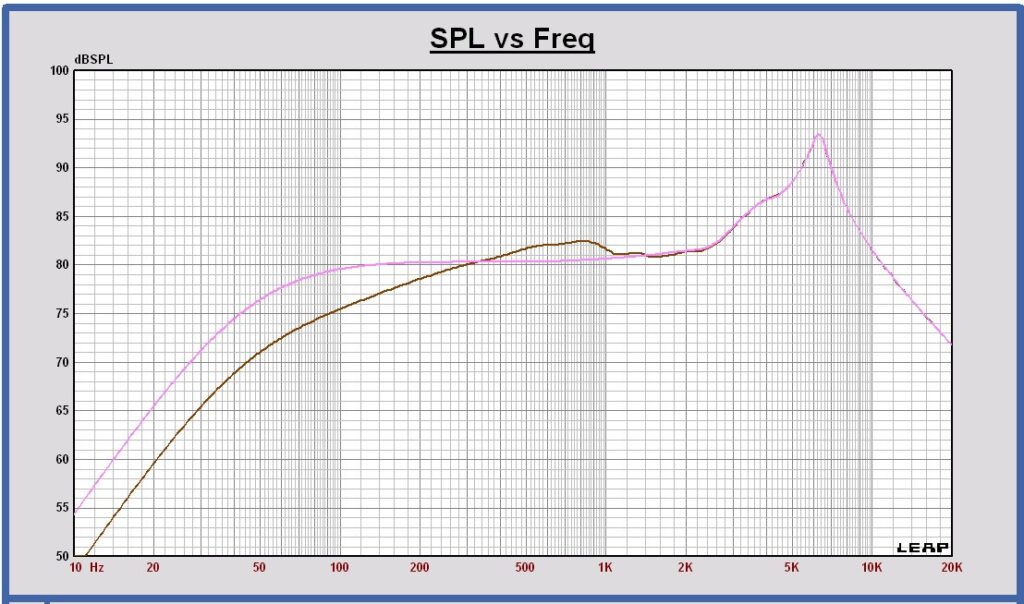
Impedance midwoofer in the cabinet
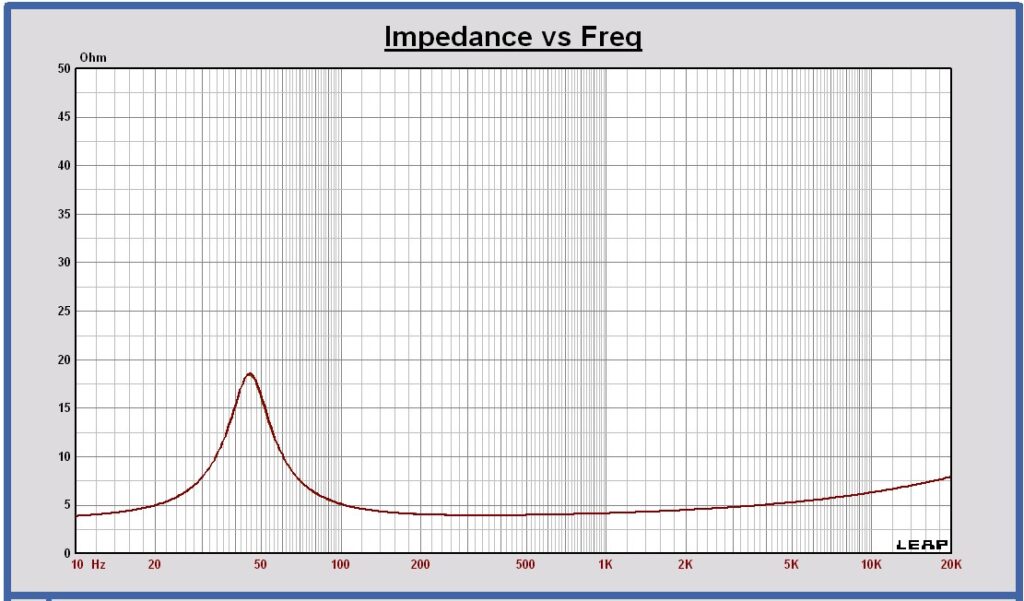
SPL midrange in the cabinet on-axis in free space (green curve) and on infinite baffle (pink curve)
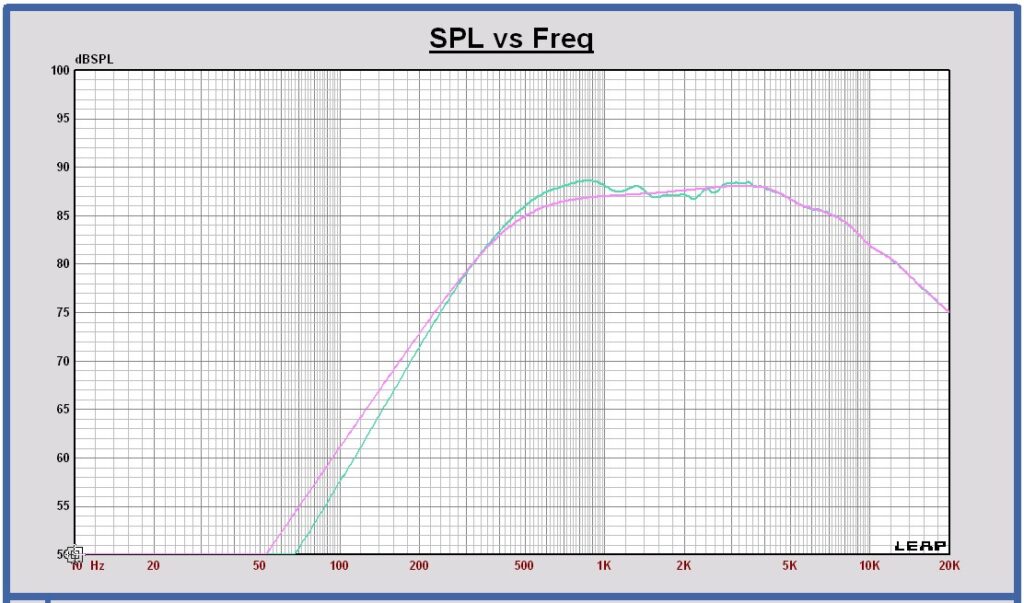
Impedance midrange in the cabinet
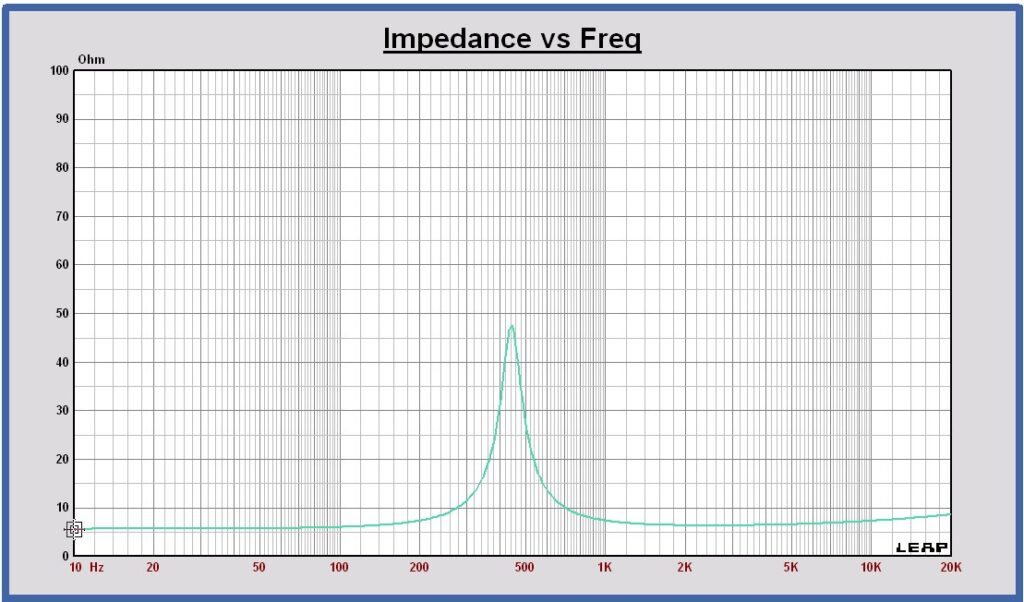
SPL tweeter in the cabinet on-axis in free space (red curve) and on infinite baffle (pink curve)

Impedance tweeter in the cabinet
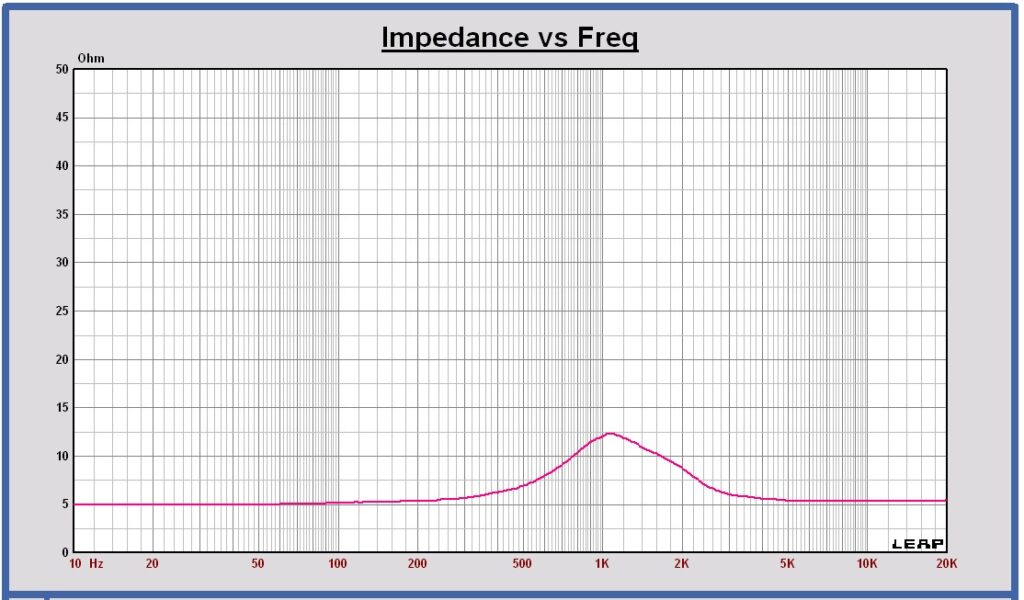
Polar diagrams
Horizontal polar diagram 2 woofers in cabinet free space at 80 – 160 – 320 – 640 – 1280 Hz
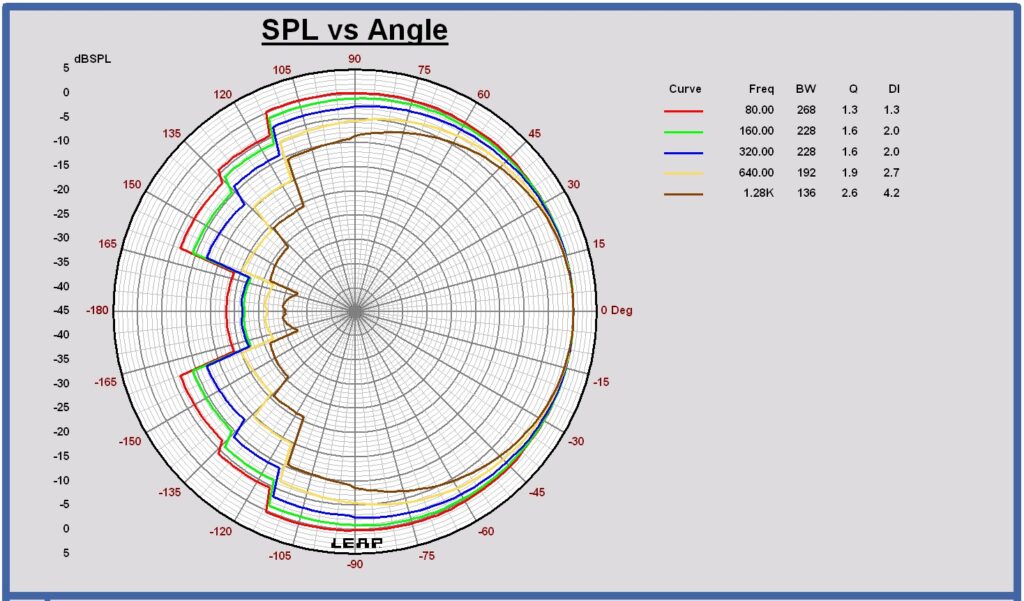
Vertical polar diagram 2 woofers in cabinet free space at 80 – 160 – 320 – 640 – 1280 Hz
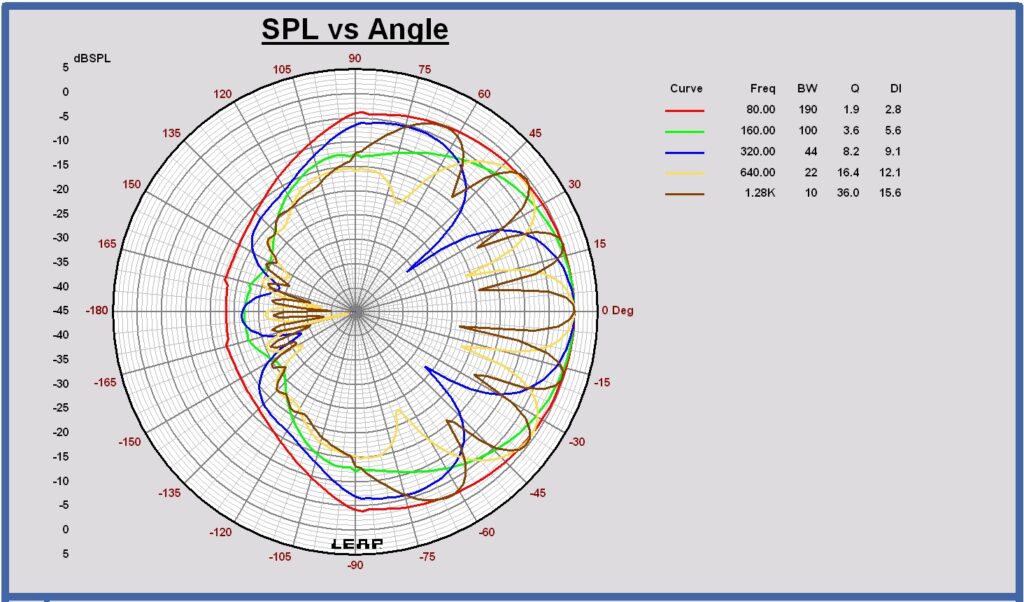
Horizontal polar diagram midwoofer in cabinet free space at 80 – 160 – 320 – 640 – 1280 Hz
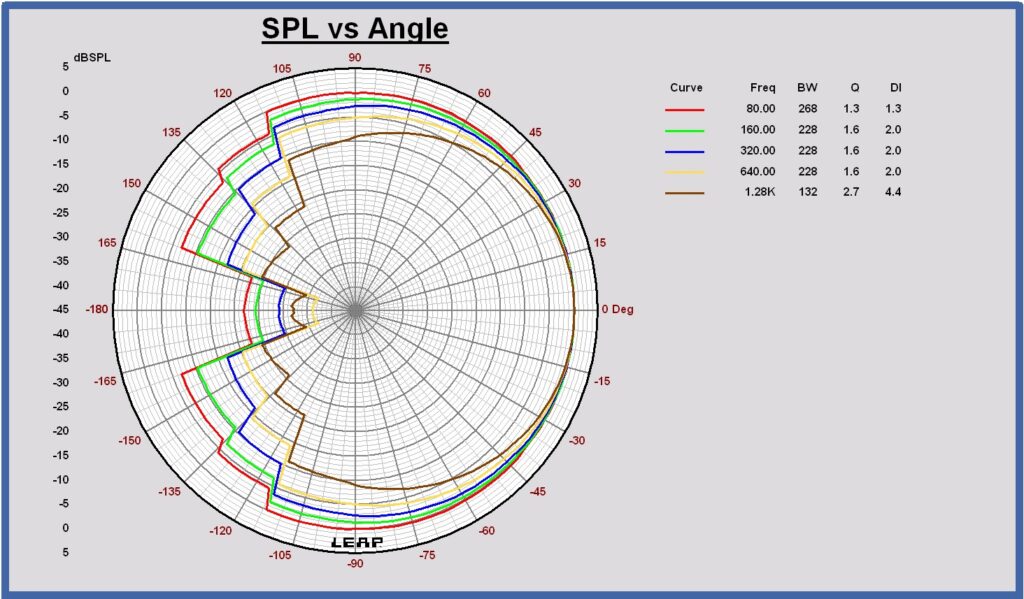
Vertical polar diagram midwoofer in cabinet free space at 80 – 160 – 320 – 640 – 1280 Hz
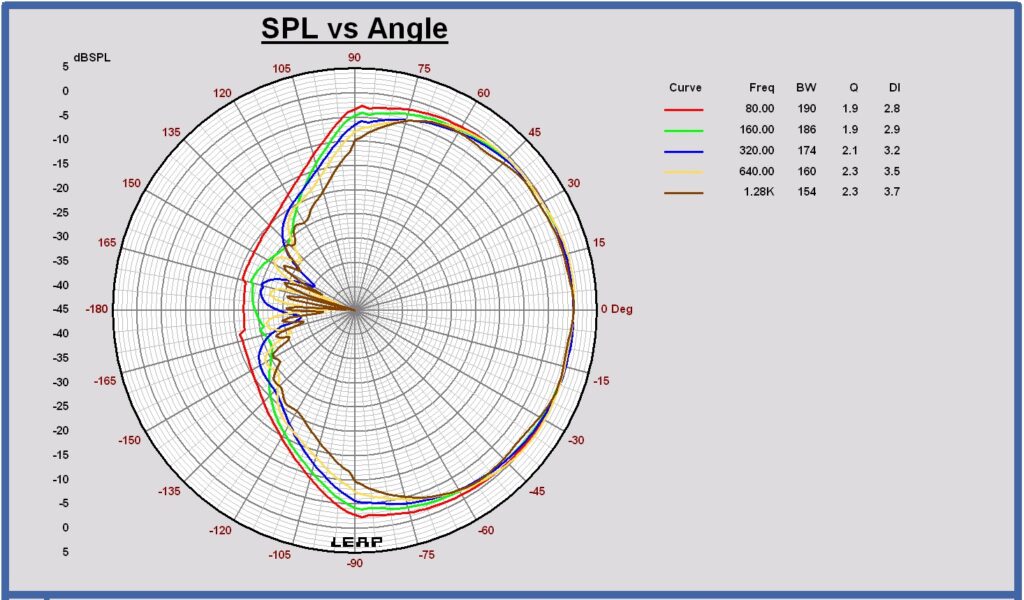
Horizontal polar diagram midrange in cabinet free space at 0.64 – 1.2 – 2.5 – 3.8 – 5.1 kHz
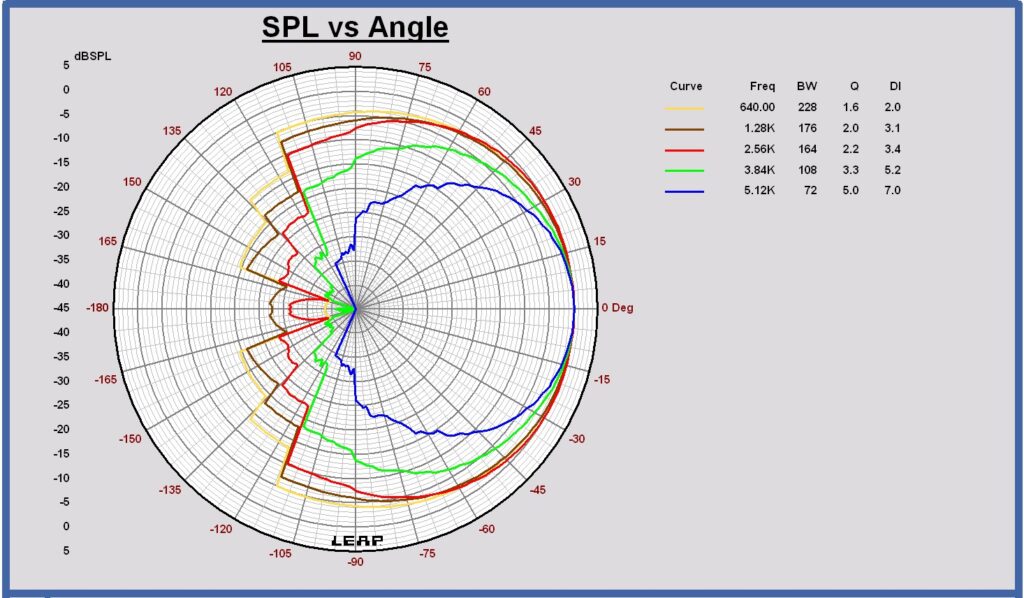
Vertical polar diagram midrange in cabinet free space at 0.64 – 1.2 – 2.5 – 3.8 – 5.1 kHz
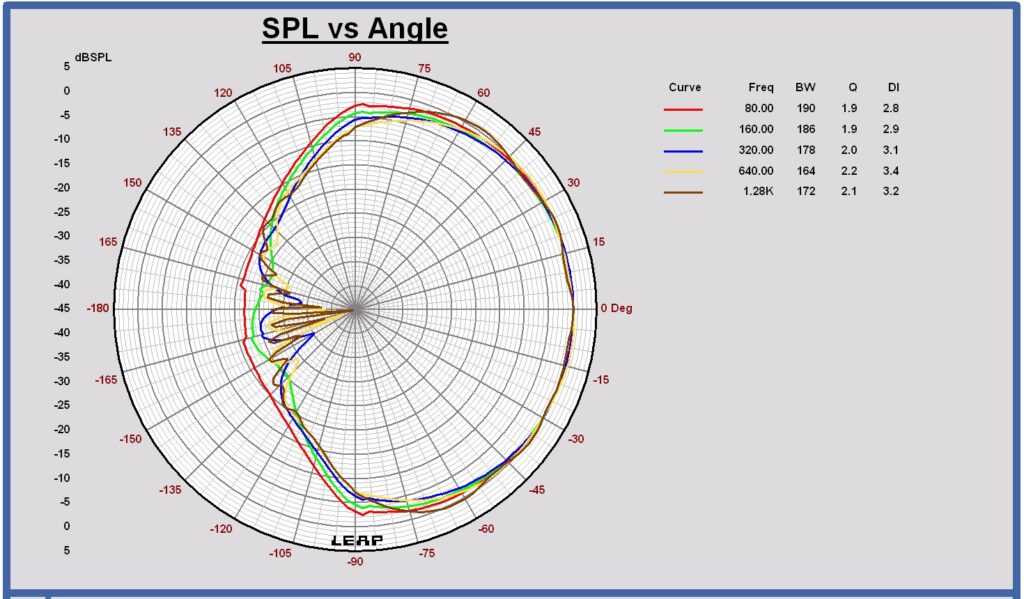
Horizontal polar diagram tweeter in cabinet free space at 1.2 – 2.5 – 3.8 – 5.1 – 6.4 – 12 kHz
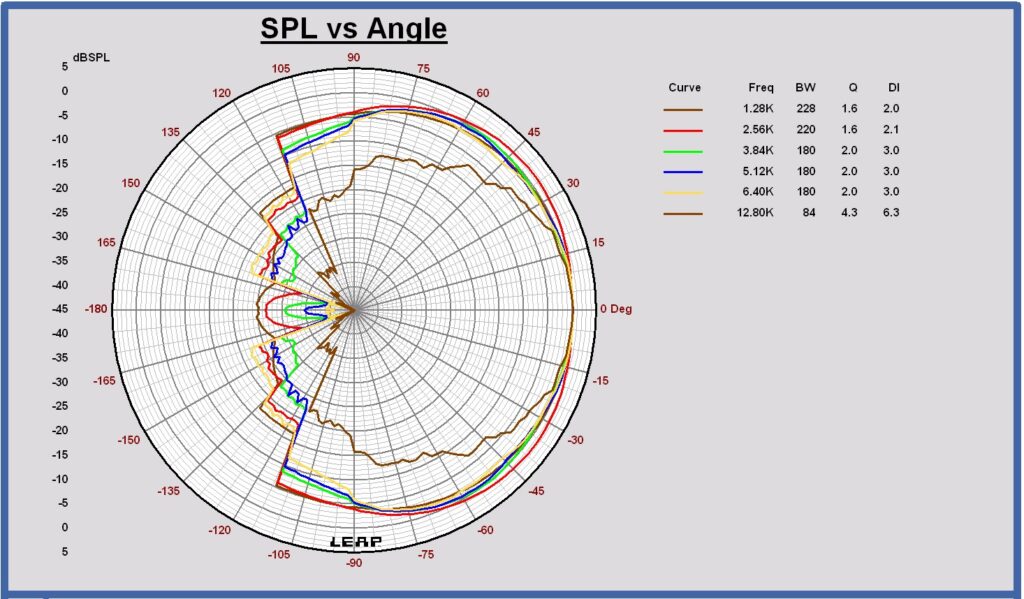
Vertical polar diagram tweeter in cabinet free space at 1.2 – 2.5 – 3.8 – 5.1 – 6.4 – 12 kHz
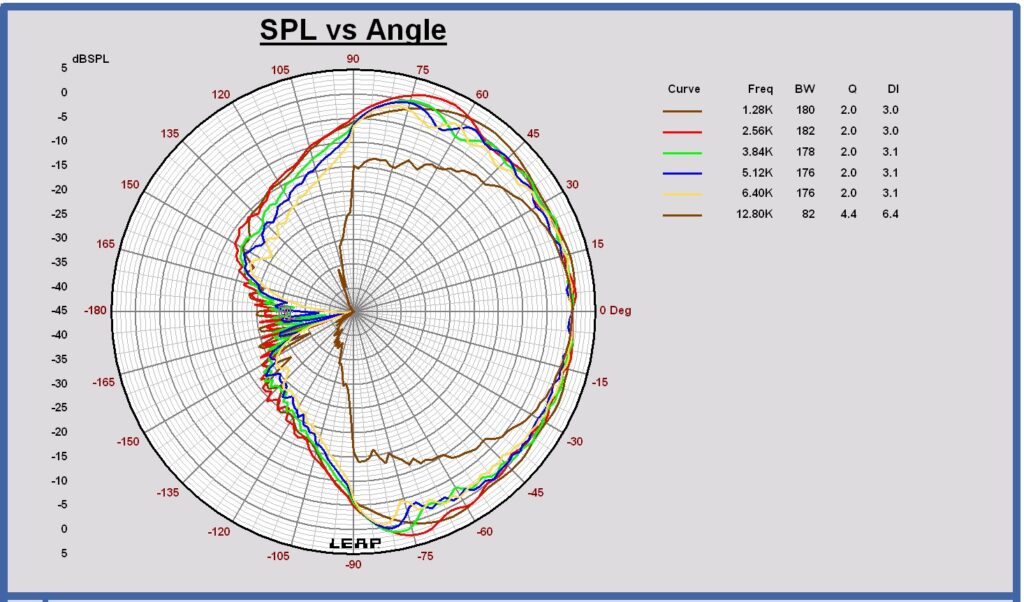
Off axis response, Power and Directivity Index of the transducers in the cabinet
To calculate the power response and directivity index, the horizontal and vertical SPL off axis responses of the woofer, the midrange and the tweeter are simulated in steps of 15 degrees, the speaker placed in a full sphere at 3m distance. The power is calculated out of the mean value of these curves. The power is represented as the SPL of an omnidirectional source at 3m distance in a full sphere with a SPL value equal to the power.
Woofers
Horizontal SPL on and off axis of the 2 woofers in the cabinet at 0, 15, 30, 45, 60, 75 and 90 degrees
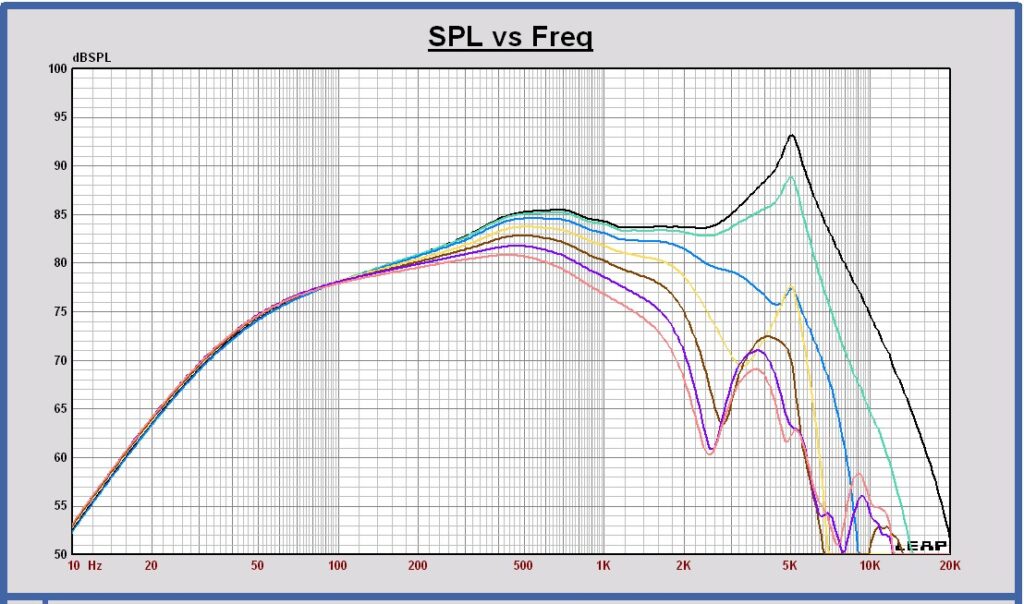
Vertical SPL on and off axis of the 2 woofers in the cabinet at 0, 15, 30, 45, 60, 75 and 90 degrees
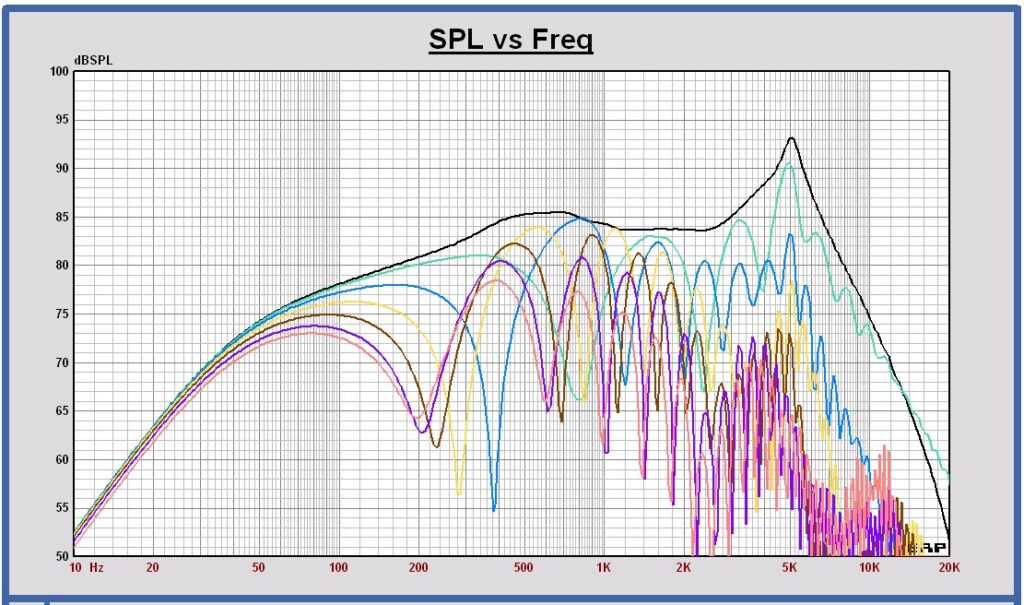
SPL on axis and Power of the 2 woofers in the cabinet in a full sphere

Directivity Index DI in a full sphere of the 2 woofers in the cabinet
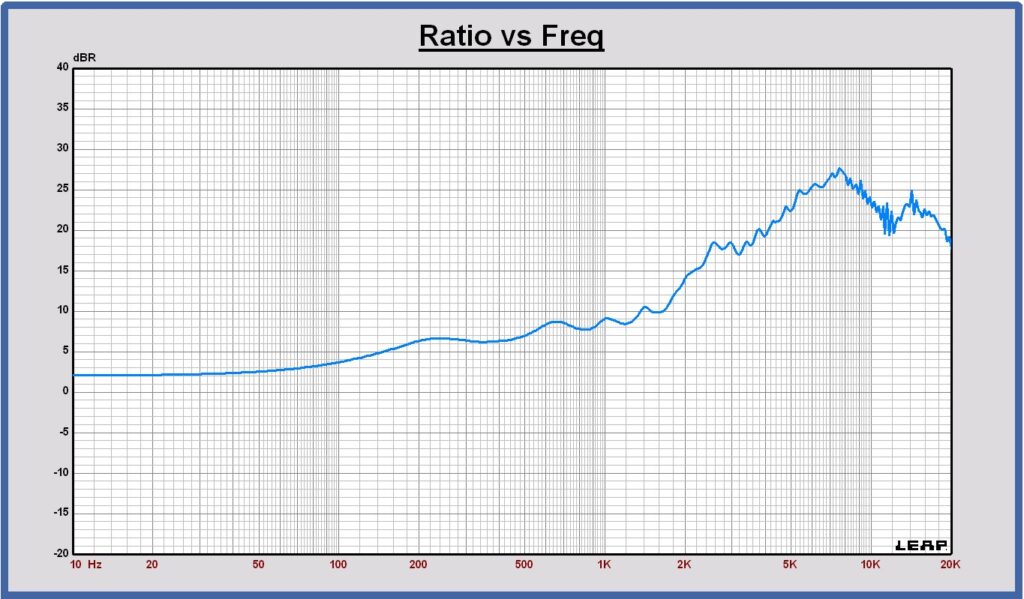
Midwoofer
Horizontal SPL on and off axis of the midwoofer in the cabinet at 0, 15, 30, 45, 60, 75 and 90 degrees
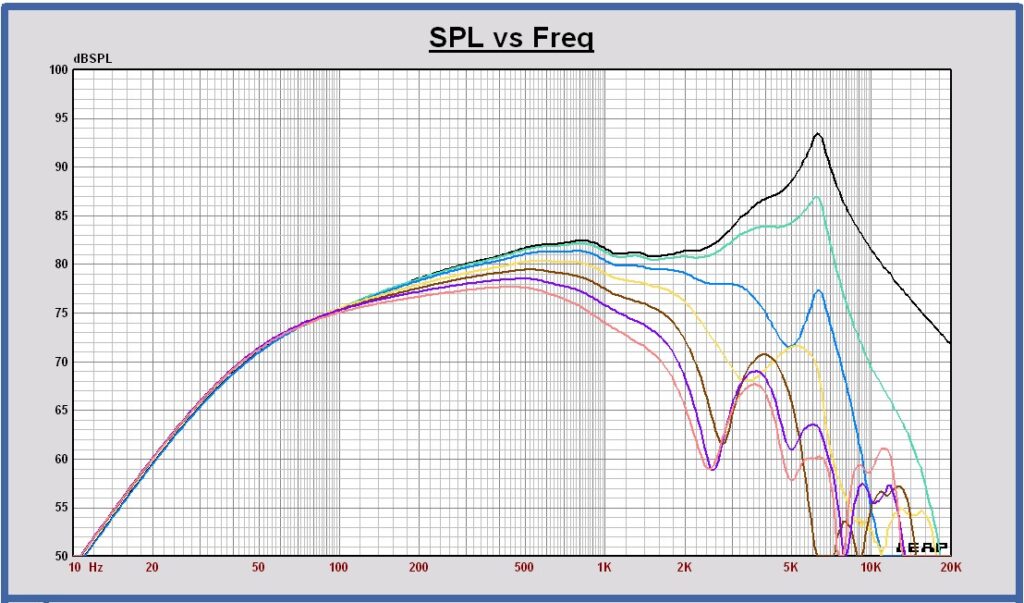
Vertical SPL on and off axis of the midwoofer in the cabinet at 0, 15, 30, 45, 60, 75 and 90 degrees
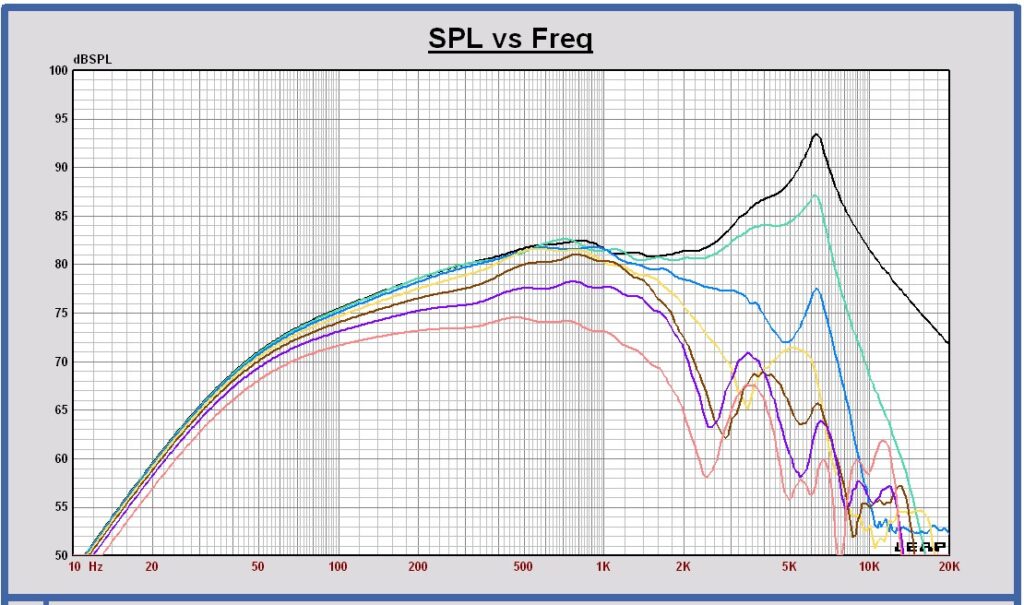
SPL on axis and Power of the midwoofer in the cabinet in a full sphere
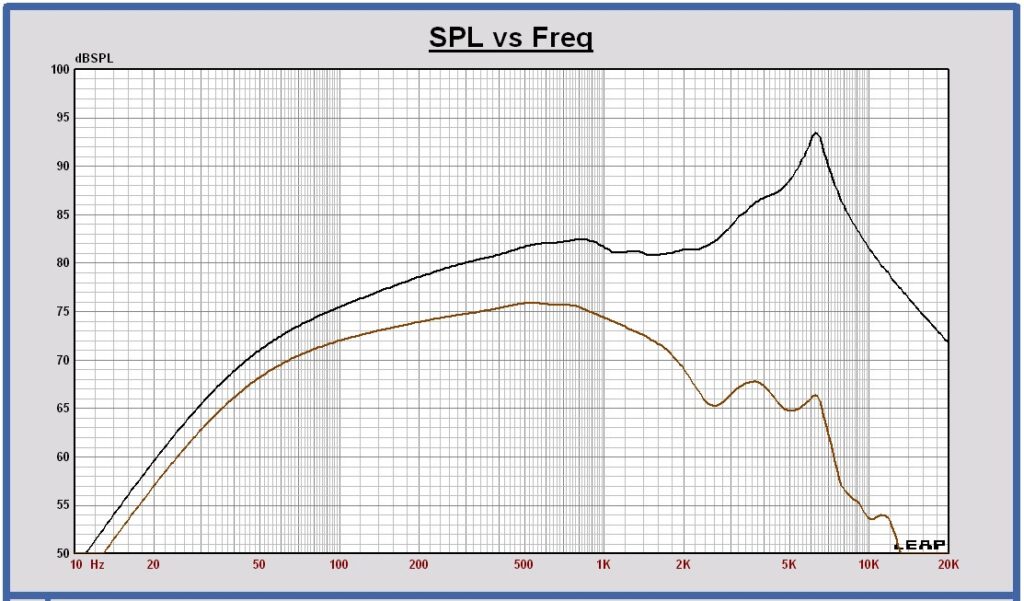
Directivity Index DI in a full sphere of the miwoofer in the cabinet
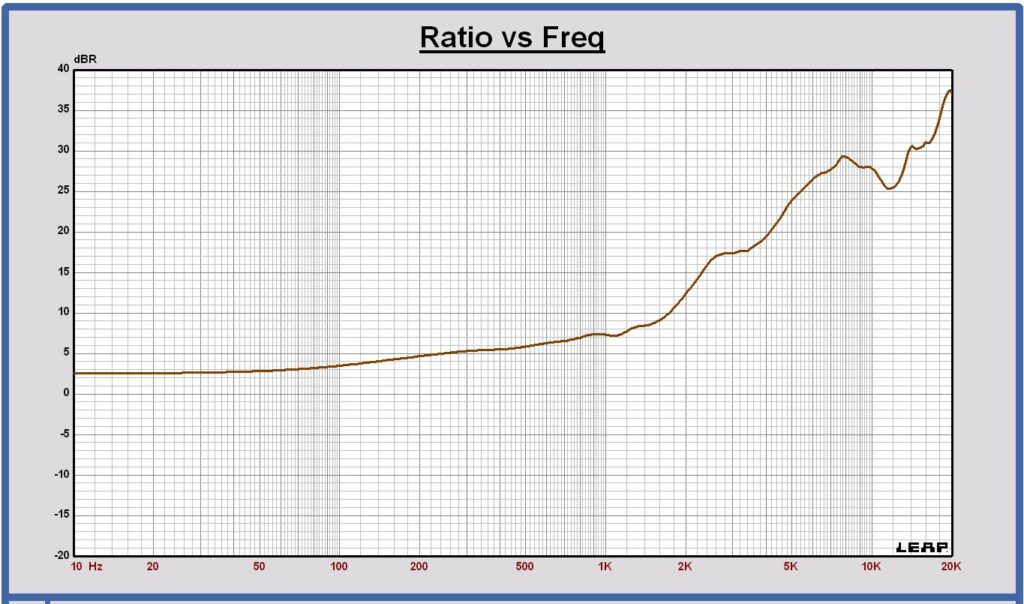
Midrange
Horizontal SPL on and off axis of the midrange in the cabinet at 0, 15, 30, 45, 60, 75 and 90 degrees
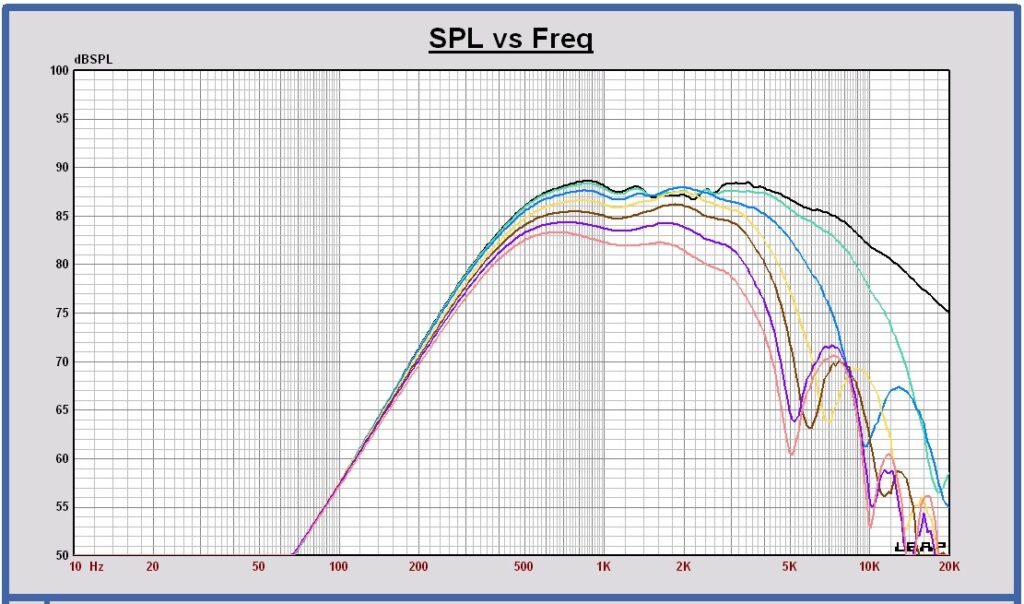
Vertical SPL on and off axis of the midrange in the cabinet at 0, 15, 30, 45, 60, 75 and 90 degrees
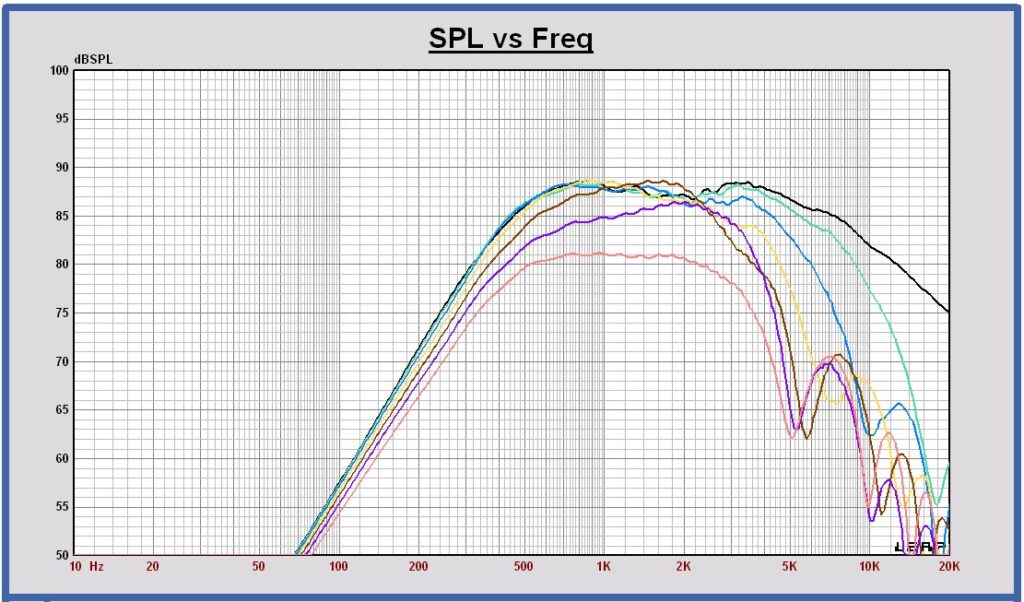
SPL on axis and Power of the midrange in the cabinet in a full sphere
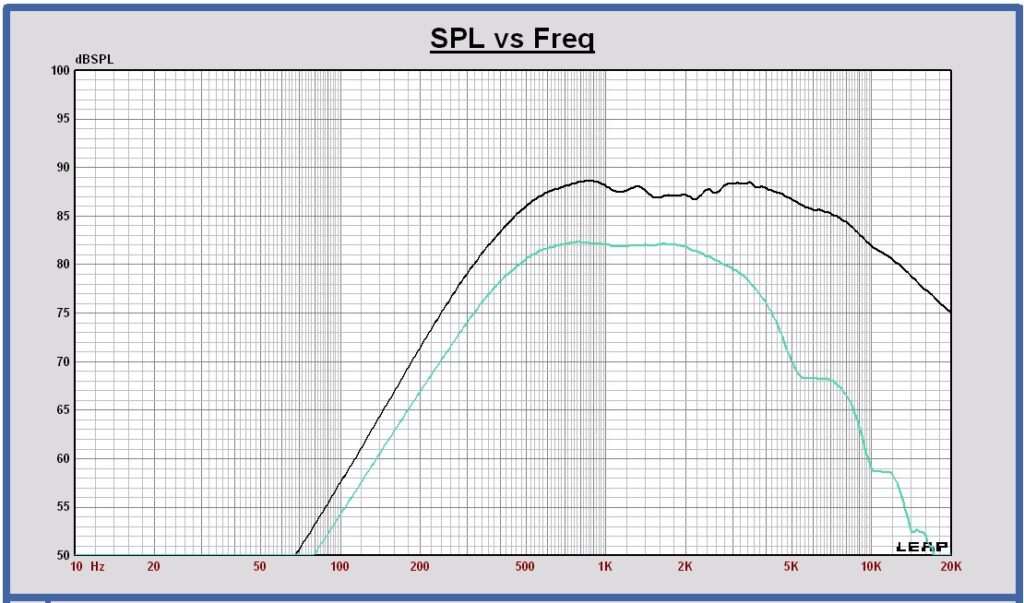
Directivity Index DI in a full sphere of the midrange in the cabinet
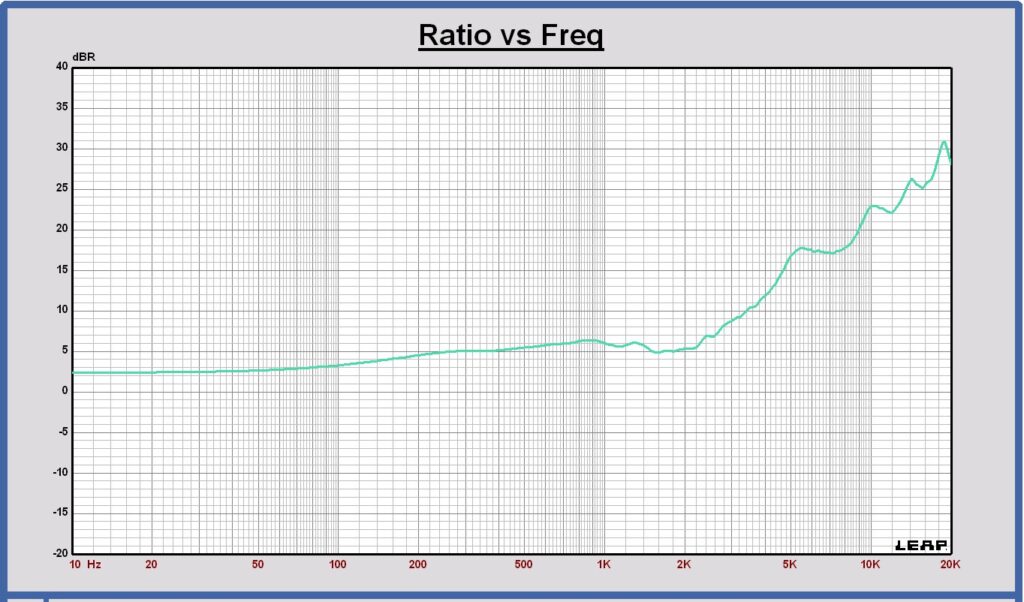
Tweeter
Horizontal SPL on and off axis of the tweeter in the cabinet at 0, 15, 30, 45, 60, 75 and 90 degrees
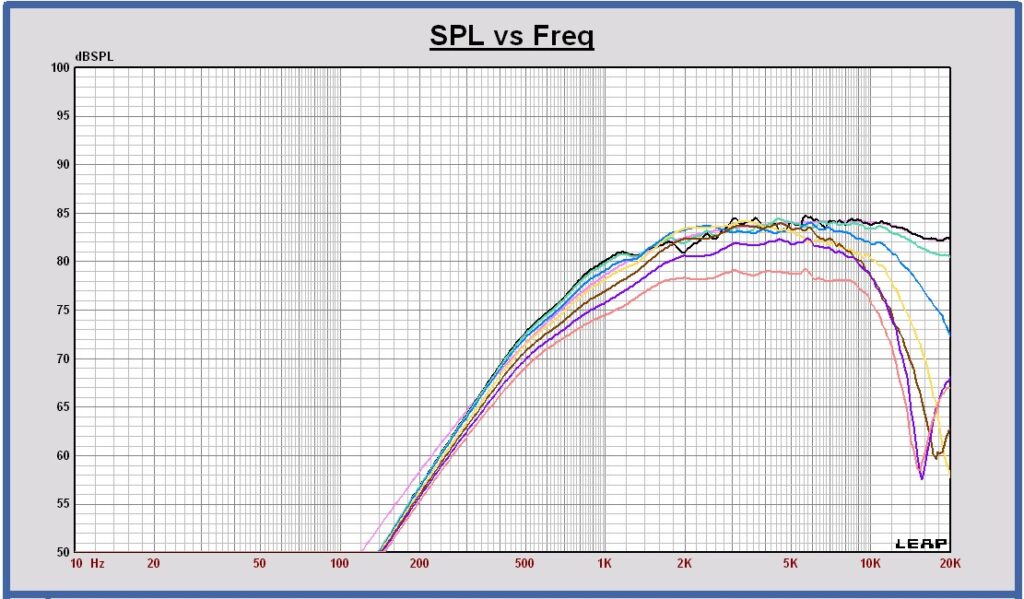
Vertical SPL on and off axis of the tweeter in the cabinet at 0, 15, 30, 45, 60, 75 and 90 degrees
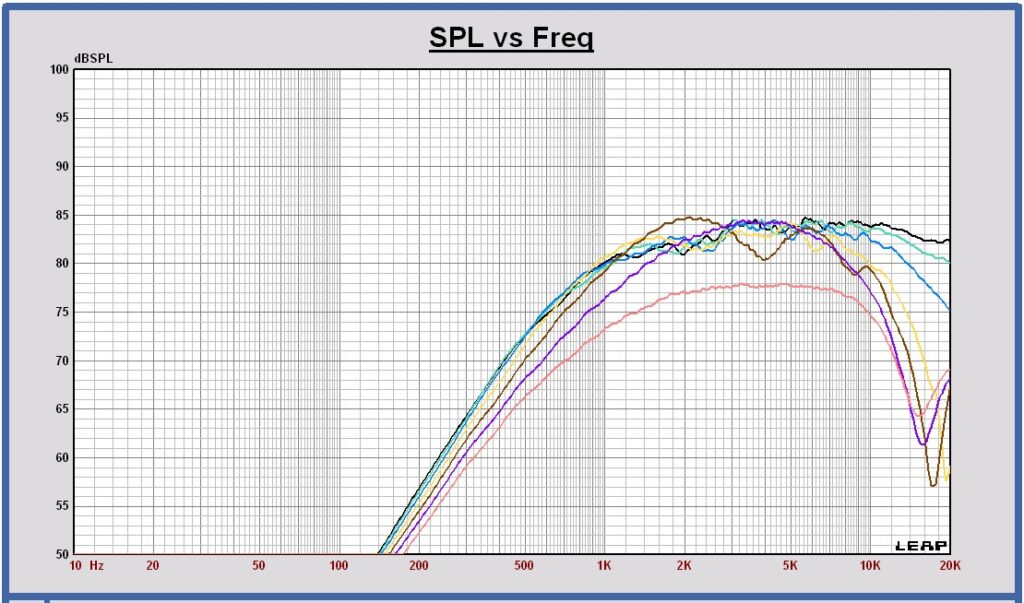
SPL on axis and Power of the tweeter in the cabinet in a full sphere
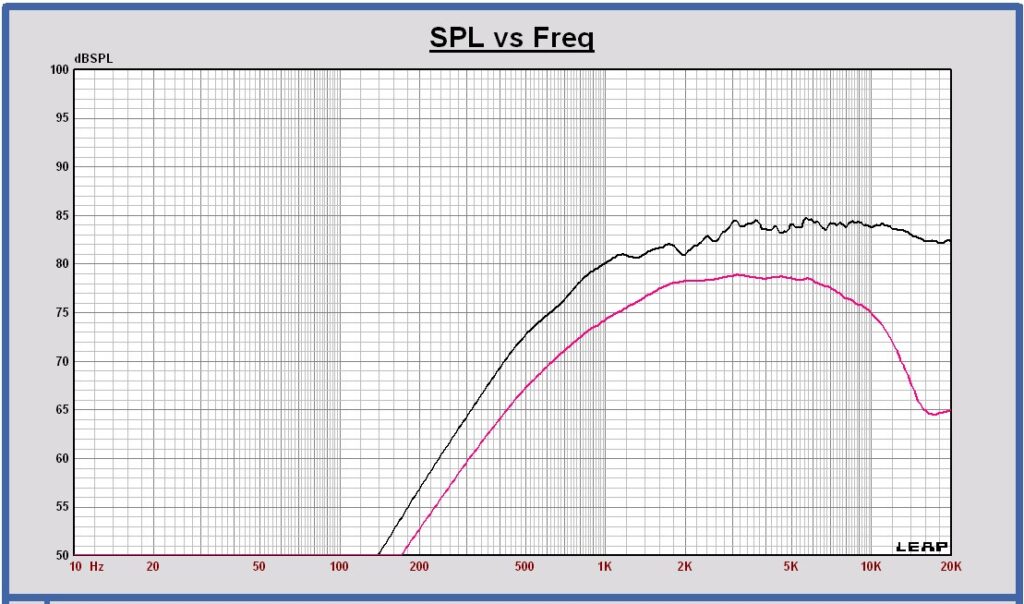
Directivity Index DI in a full sphere of the tweeter in the cabinet
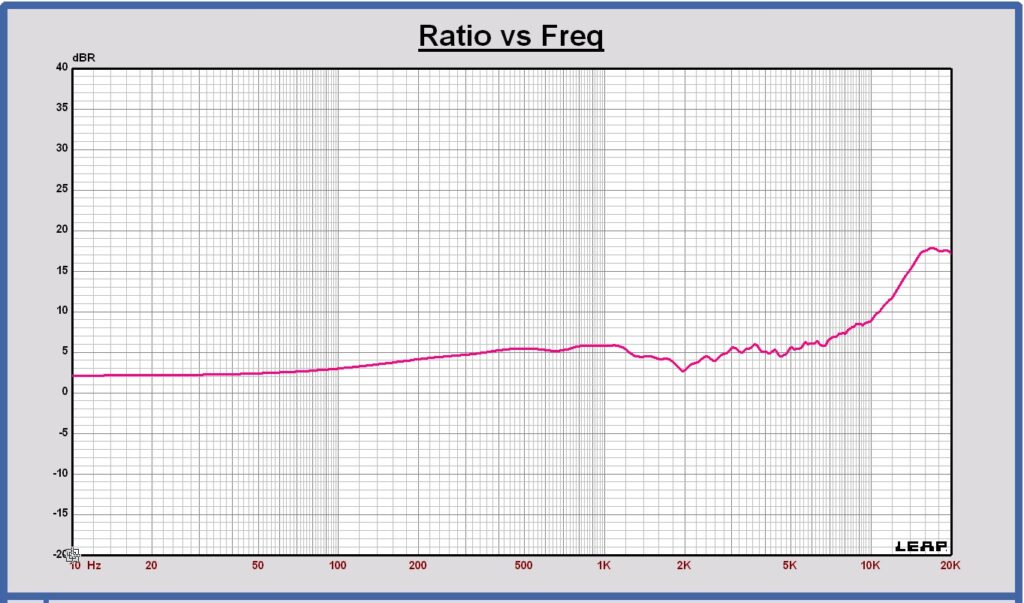
All transducers
Directivity Index DI in a full sphere of the woofer, midrange and tweeter in the cabinet
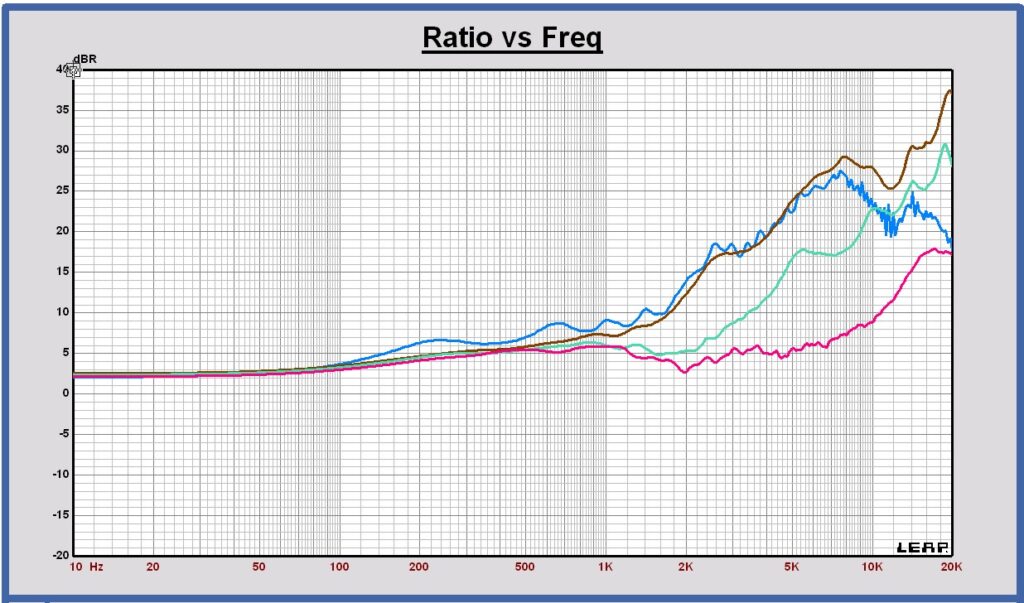
- The 4 transducers show a smooth DI curve as a function of frequency. The woofer DI being around 5 at 120 Hz, is realized with the 2 woofer driver array in this speaker cabinet.
- The DI dip of the tweeter at 2 kHz is caused by diffraction. The tweeter operating range will be chosen at a higher frequency.
- To realize a well behaving and constant DI as a function of frequency, the crossover frequencies will be chosen at 110, 550 and 2750 Hz.
Active crossover filter with generic filter blocks
A Linkwitz-Riley 4th order crossover filter is designed. The crossover frequencies are chosen at 110, 550 and 2750 Hz. To get a speaker sensitivity of 85 dB at 1m, 2.83 Vrms in full space, the F3 for this speaker is chosen at 40 Hz with a 2nd order Butterworth fall off to low frequencies.
Crossover filter targets LR4 at 110, 550 and 2750 Hz
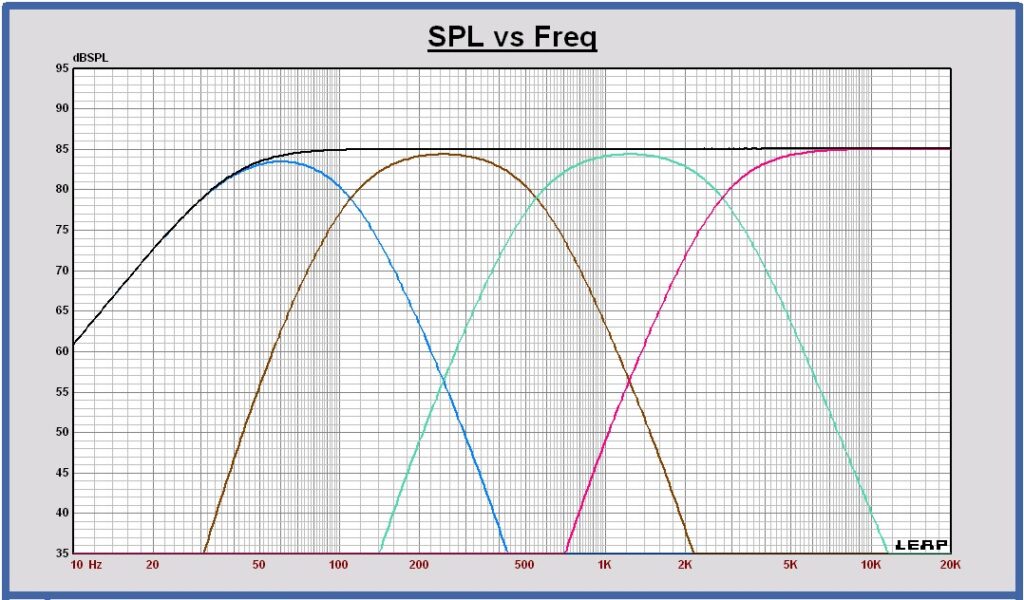
Crossover filter schematic with generic filter blocks
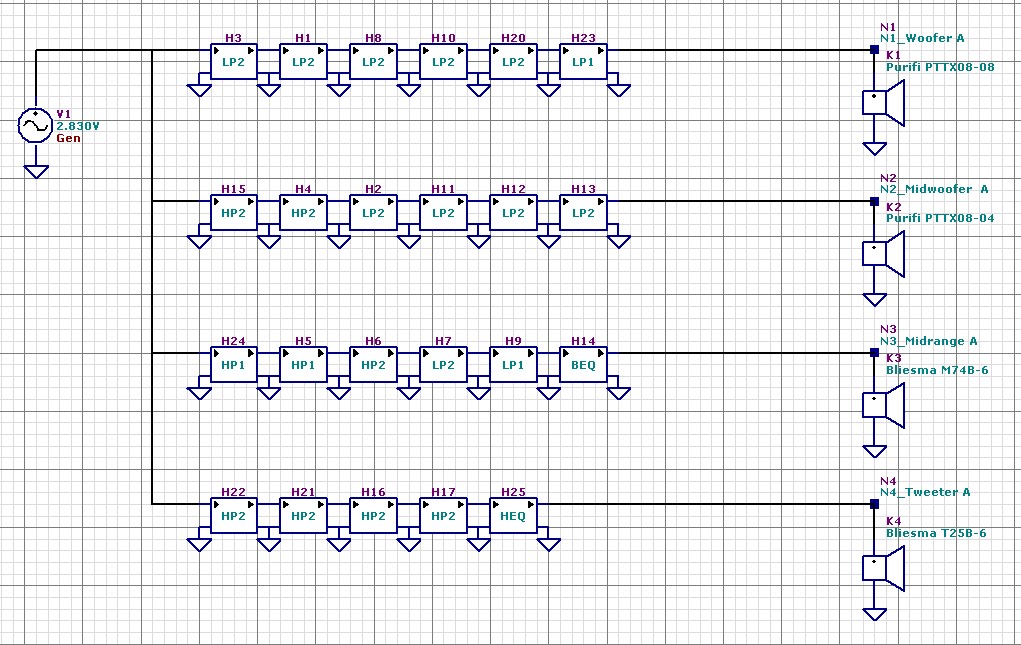
woofer filter: 5 x LP2 Low Pass 2nd order filter, 1 x LP1 Low Pass filter 1st order
midwoofer filter: 2 x HP2 High Pass 2nd order filter and 4 x LP2 Low Pass 2nd order filter
midrange filter: 2 x HP1 High Pass 1st order filter, 1 x HP2 High Pass 2nd order filter,1 x LP2 Low Pass 2nd order filter, 1 x LP1 Low Pass 1st order folter and 1 x BEQ Parametric 2nd order Band Equalizer
tweeter filter: 4 x HP2 High Pass 2nd order filter and 1 x HEQ High Pass Equalization Filter
Component values are not mentioned in the schematic. Please contact us if more details are wanted.
SPL on axis of the filtered drivers and the sum at 1m, 2.83 Vrms
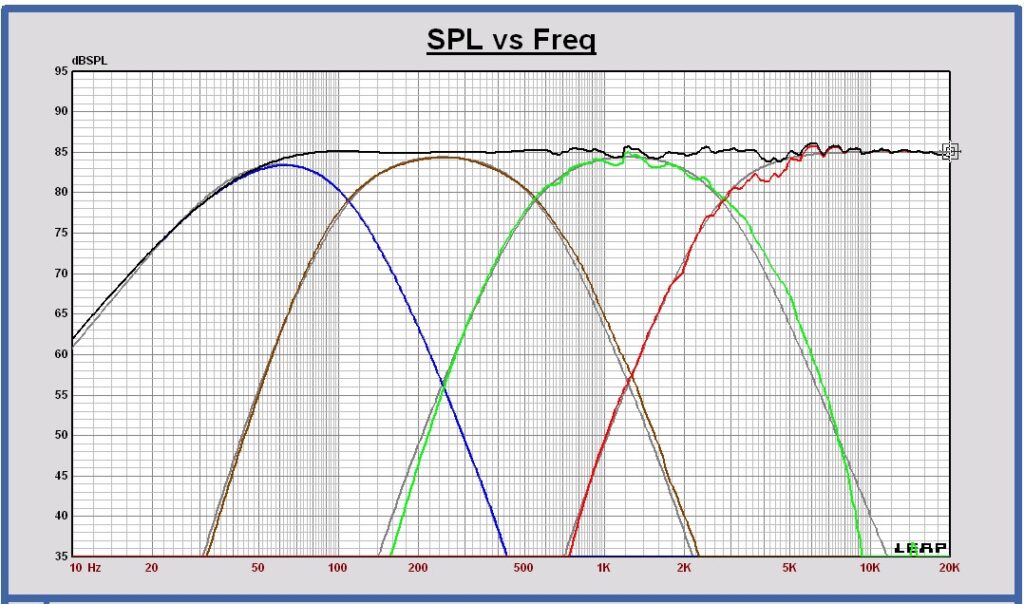
Phase response of the filtered drivers and the sum in free space at 3m
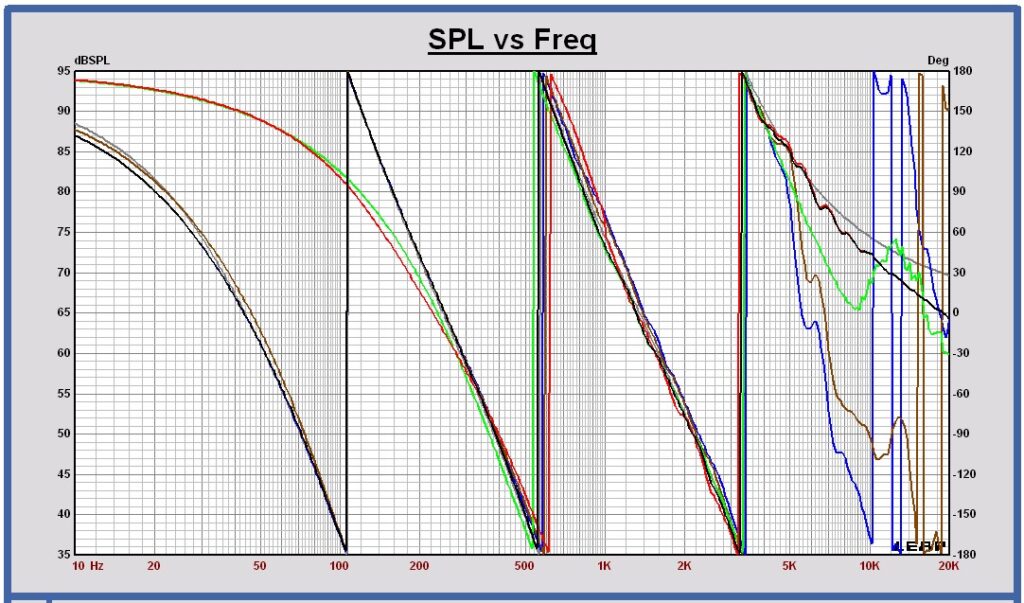
SPL horizontal off axis of the sum at 0 , 15, 30, 45 and 60 degrees at 3m, 2.83 Vrms
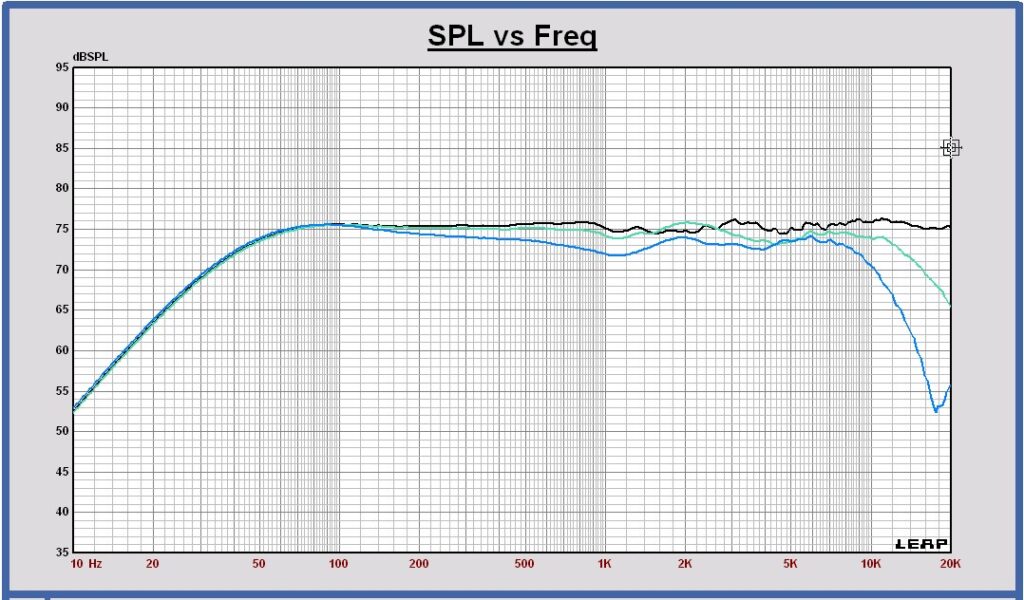
Power response of the filtered drivers and the sum in free space at 3m, 2.83 Vrms
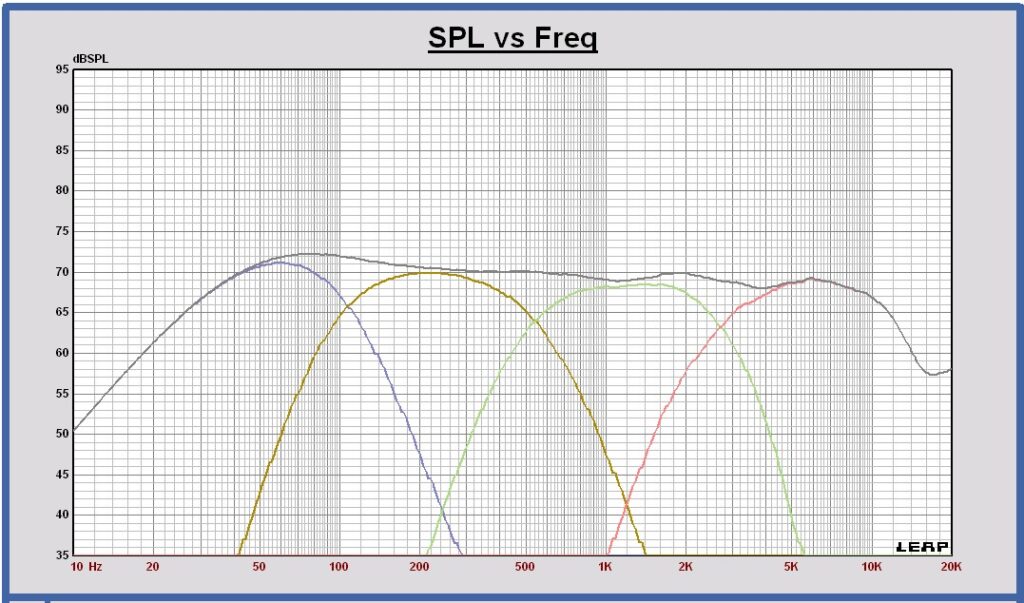
Directivity Index in free space of the filtered drivers and the sum
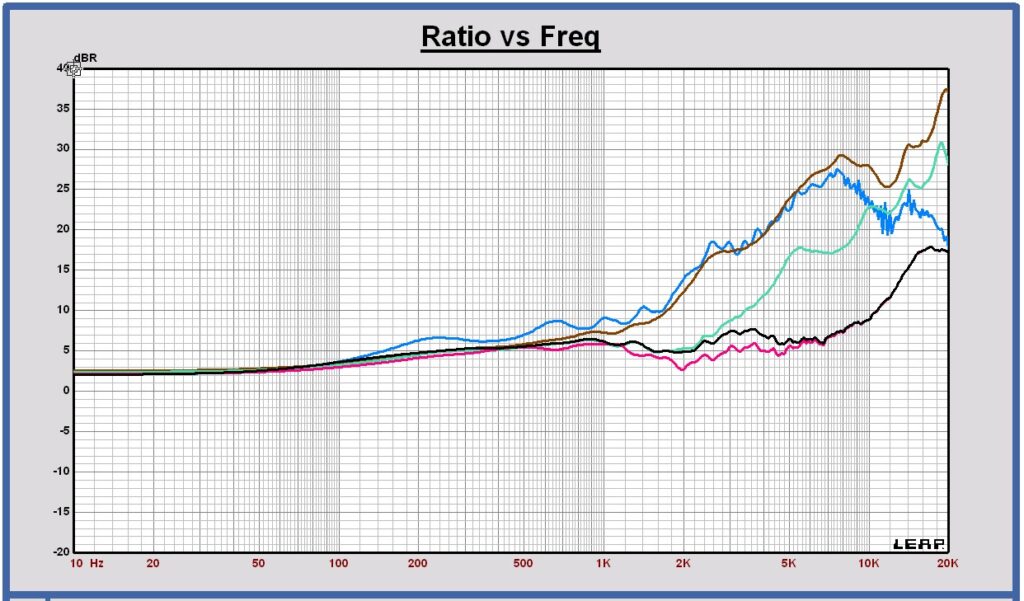
Maximum excursion and maximum SPL with the LR4 filter
With the designed Linkwitz – Riley 4th order filter, each woofer has a maximum excursion of 9.3 mm peak at 40 Hz for a voltage of 21.6 Vrms at the input of the filter.
The excursion of the midwoofer, midrange and the tweeter have been calculated also at 21.6 Vrms.
Excursion at 21.6 Vrms of woofer (blue), midwoofer (brown), midrange (green) and tweeter (red)
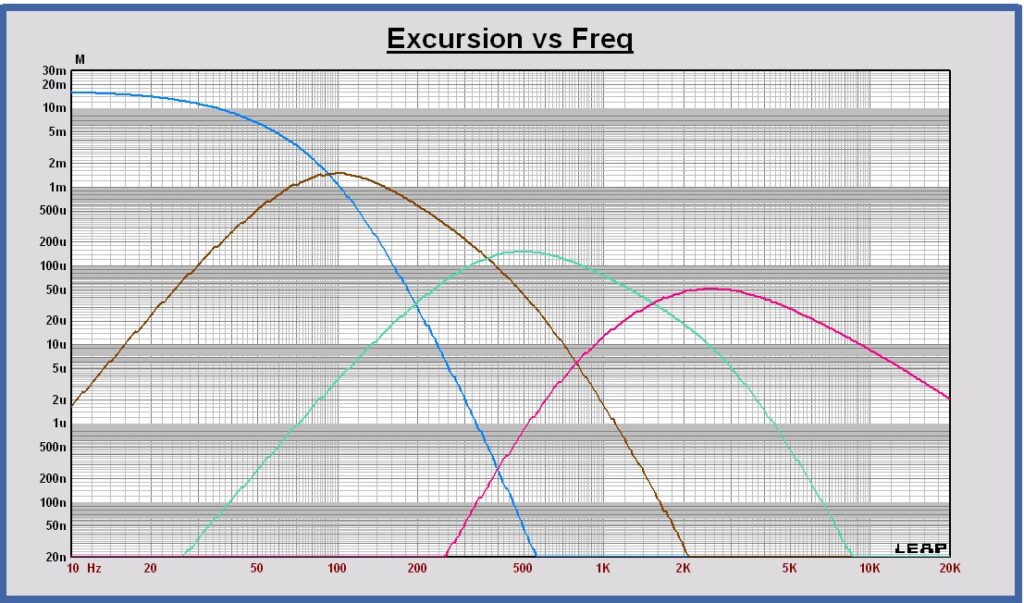
The midwoofer excursion is maximum at 102 Hz and equal to 1.48 mm peak.
The maximum specified linear excursion of the Purifi PTT8.0X04-NAB-02 is 9.3 mm peak.
The midrange excursion is maximum at 506 Hz and equal to 0.151mm peak.
The maximum specified linear excursion of the Bliesma M74B-6 is 1.2 mm peak.
The tweeter excursion is maximum at 2655 Hz and equal to 0.052 mm peak.
The maximum linear excursion of the Bliesma T25B-6 is 1.0 mm peak.
Maximum SPL
The maximum SPL for the operating frequency range 40 – 20000 Hz at maximum excursion of each woofer is 99.3 dB at 1m, 21.6 Vrms at the input of the crossover filter.
DSP digital active crossover filter
For a DSP active system, each generic filter block will be transformed to a biquad filter block. These blocks can be imported in the used DSP, like miniDSP for example.
We already made the miniDSP Flex Eight configuration file for the LR4 110 550 2750 Hz crossover filter.
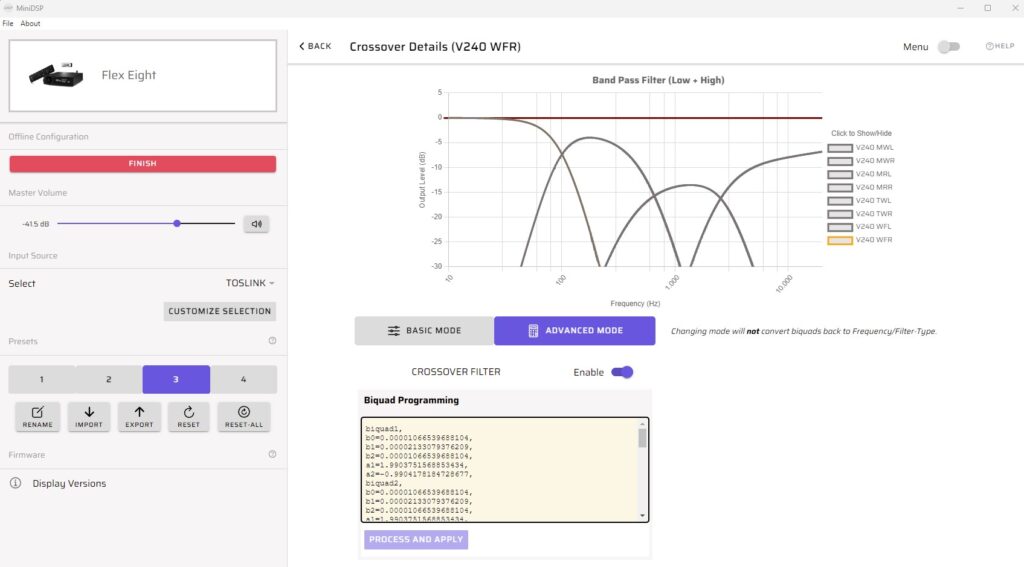
As a compensation for the acoustical center differences of the loudspeaker transducers, digital delays have to be applied for the midrange and the tweeter crossover filter.
In the same way miniDSP Flex Eight configuration files can be made for other filter types or other transducers.
ASP analog active crossover filter
For an ASP analog active system, each generic filter block will be transformed to an opamp filter block.
As a compensation for the acoustical center differences of the loudspeaker transducers, all pass filtering have to be added for the midrange and the tweeter crossover filter.
As an example we did the transform for the VCL EX27 LR4 110 – 550 – 2750 Hz filter. All pass filtering for the midrange and tweeter filter is not included yet in the schematic examples.
VCL EX27 ASP Woofer Filter
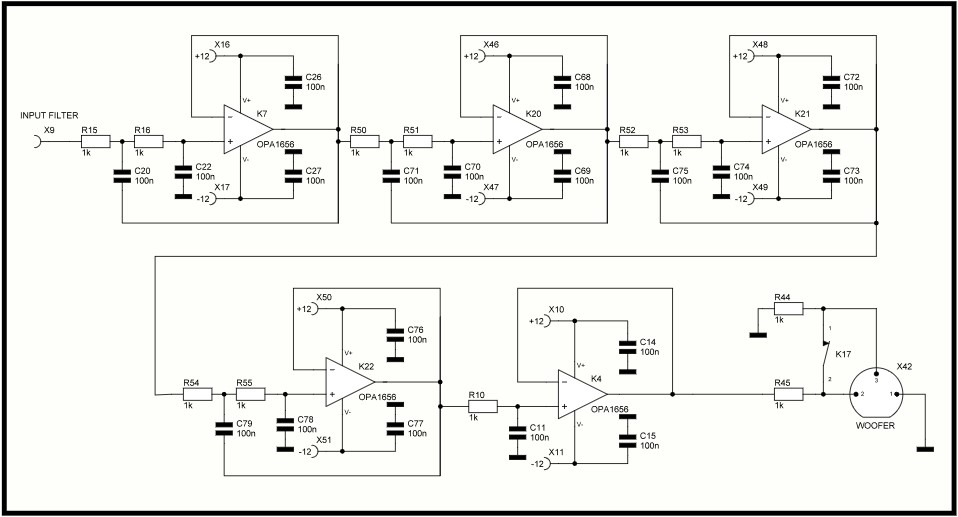
VCL EX27 ASP Midwoofer Filter
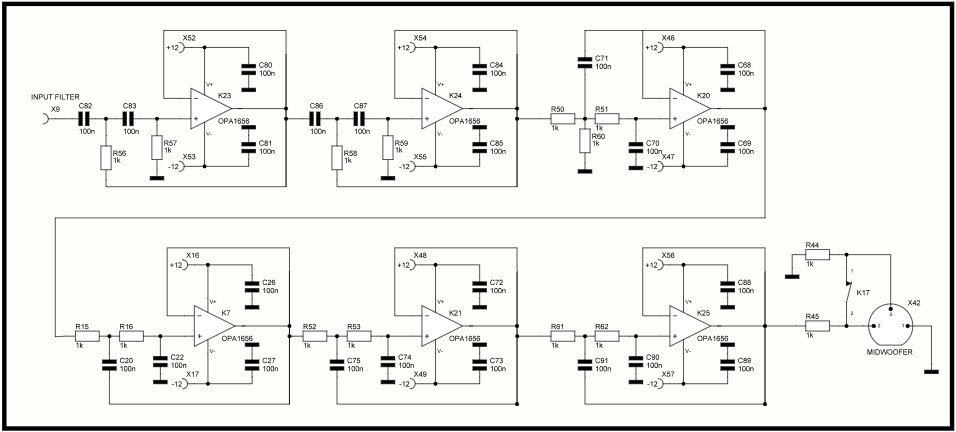
VCL EX27 ASP Midrange Filter
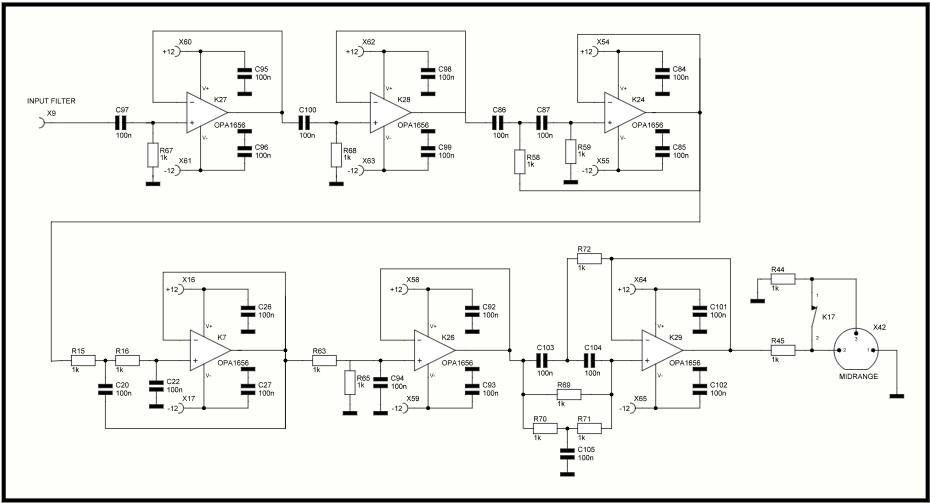
VCL EX27 ASP Tweeter Filter
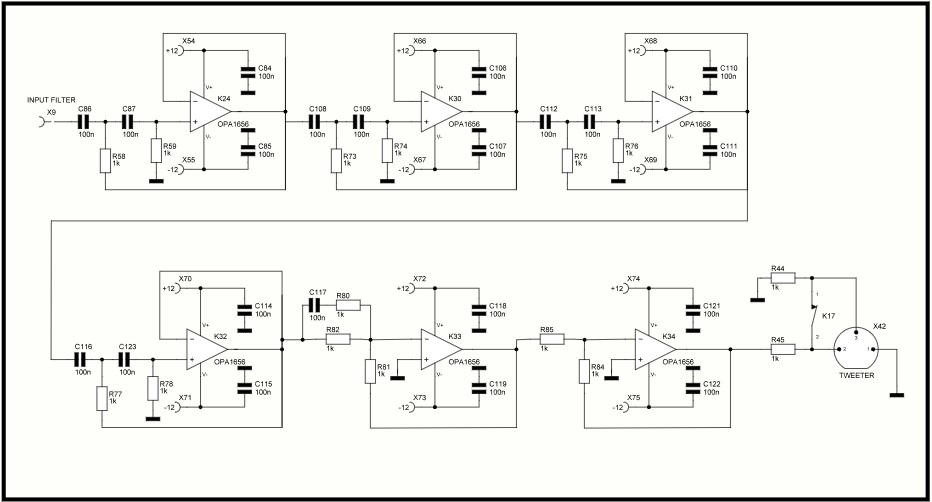
Passive filter 3-way module
It is possible to built only the 3-way part of the EX27 speaker. Or build the 3-way first and add the two woofers afterwards. A passive flter is designed to realize such stand alone 3-way.
The 3-way with passive filtering can also be combined with the two woofers in an active system and active LR4 filtered at 110 Hz with a DSP or ASP crossover filter. In that way, the active system of the speaker becomes a 2-way at 110 Hz.
For this 3-way passive version:
- Low frequency response: F3 = 47 Hz, F6 = 38 Hz and F12 = 25 Hz
- Sensitivity: 83 dB at 1m, 2.83 Vrms, full space
- SPL at maximum excursion, 47 – 20000 Hz: 96.6 dB, 1m, full space @ 19.2 Vrms at the input of the filter
Crossover filter targets LR4 at 550 and 2750 Hz @ VCL EX27 3-way passive version
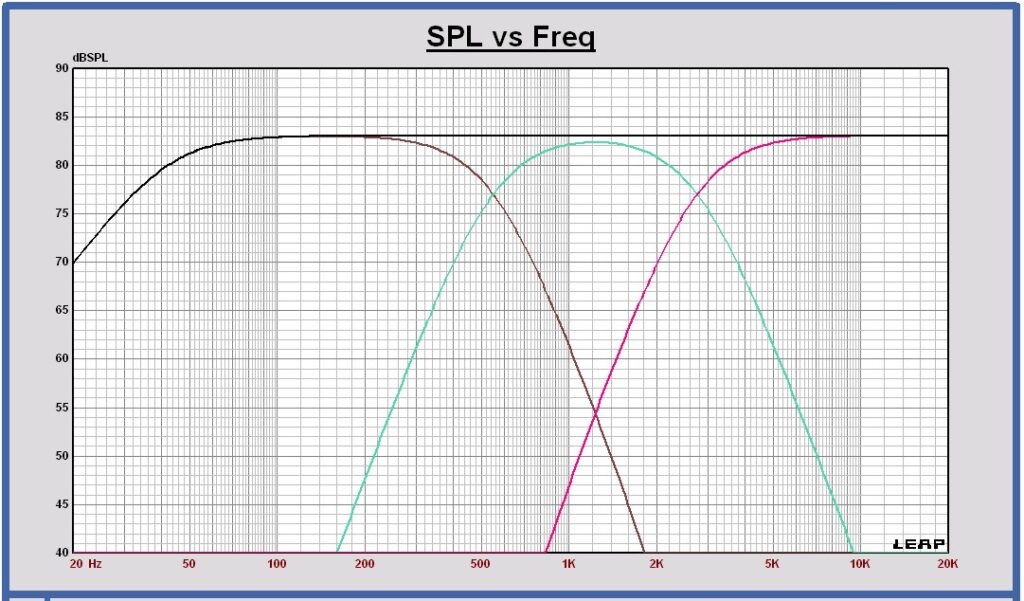
Crossover filter schematic @ VCL EX27 3-way passive version
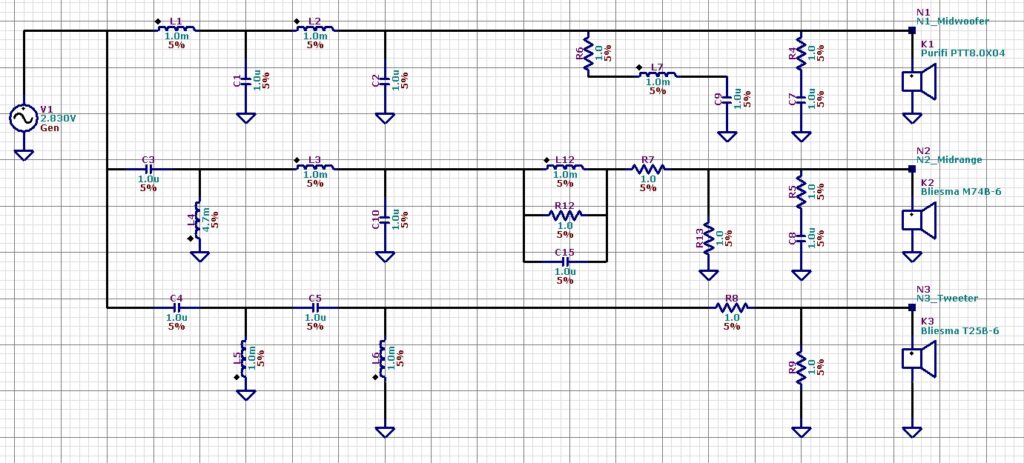
SPL on axis of the filtered drivers and the sum at 1m, 2.83 Vrms @ VCL EX27 3-way passive version
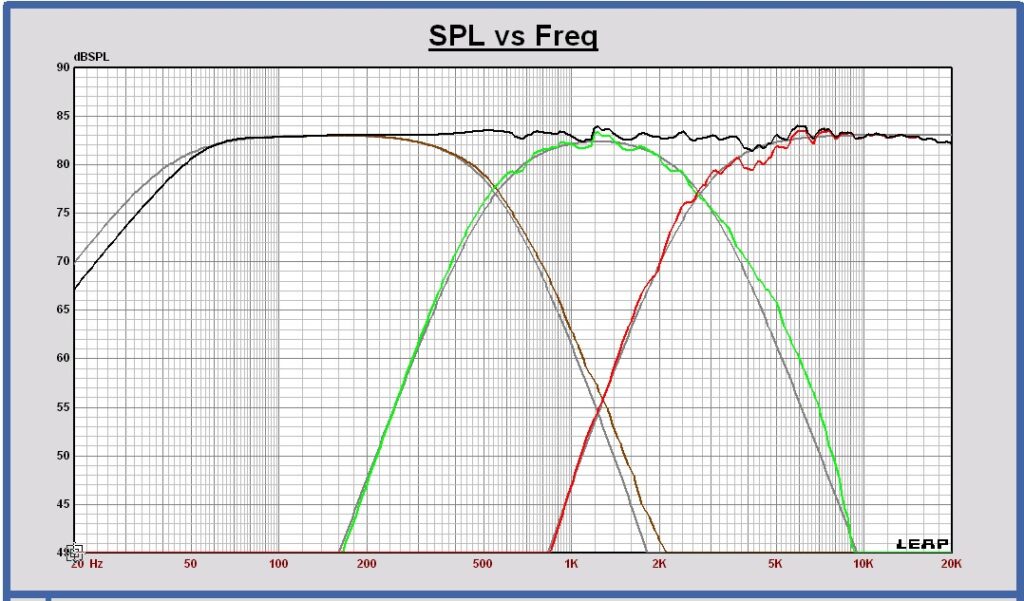
Impedance at the input of the filter @ VCL EX27 3-way passive version
